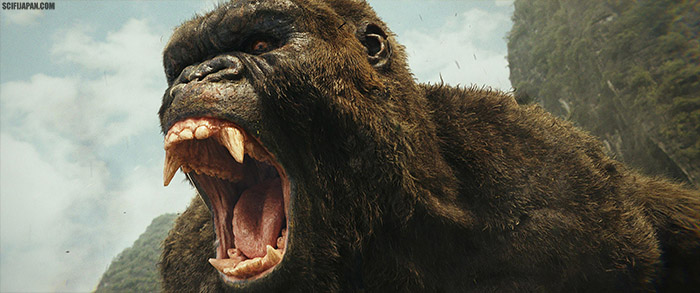 SciFi Japan has Warner Bros` official production notes and more than 40 high-res pics from the new movie, KONG: SKULL ISLAND. Photo courtesy of Warner Bros. Pictures. © 2017 WARNER BROS.ENTERTAINMENT INC., LEGENDARY PICTURES PRODUCTIONS, LLC AND PATPAC-DUNE ENTERTAINMENT LLC. ALL RIGHTS RESERVED
SciFi Japan has Warner Bros` official production notes and more than 40 high-res pics from the new movie, KONG: SKULL ISLAND. Photo courtesy of Warner Bros. Pictures. © 2017 WARNER BROS.ENTERTAINMENT INC., LEGENDARY PICTURES PRODUCTIONS, LLC AND PATPAC-DUNE ENTERTAINMENT LLC. ALL RIGHTS RESERVEDSource: Warner Bros. Pictures Official Site: kongskullislandmovie.com (US), kingkong-dokuro.jp (Japan)
SPOILER WARNING: This article contains plot details and images from an upcoming movie.
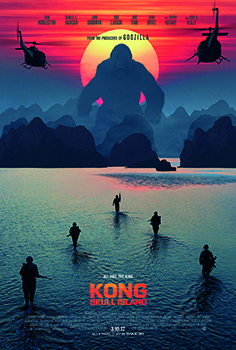 Image courtesy of Warner Bros. Pictures. © 2017 WARNER BROS.ENTERTAINMENT INC., LEGENDARY PICTURES PRODUCTIONS, LLC AND PATPAC-DUNE ENTERTAINMENT LLC. ALL RIGHTS RESERVED
Image courtesy of Warner Bros. Pictures. © 2017 WARNER BROS.ENTERTAINMENT INC., LEGENDARY PICTURES PRODUCTIONS, LLC AND PATPAC-DUNE ENTERTAINMENT LLC. ALL RIGHTS RESERVEDThe producers of GODZILLA reimagine the origins of one the most powerful monster myths of all in KONG: SKULL ISLAND, from Warner Bros. Pictures, Legendary Pictures and Tencent Pictures. A compelling, original adventure from director Jordan Vogt-Roberts (“The Kings of Summer”), the film tells the story of a diverse team of scientists, soldiers and adventurers uniting to explore a mythical, uncharted island in the Pacific, as dangerous as it is beautiful. Cut off from everything they know, the team ventures into the domain of the mighty Kong, igniting the ultimate battle between man and nature. As their mission of discovery becomes one of survival, they must fight to escape a primal Eden in which humanity does not belong. “Kong: Skull Island” stars Tom Hiddleston (“The Avengers,” “Thor: The Dark World”), Oscar nominee Samuel L. Jackson (“Pulp Fiction,” “Avengers: Age of Ultron”), John Goodman (“Transformers: Age of Extinction,” “Argo”), Oscar winner Brie Larson (“Room,” “Trainwreck”), Jing Tian (“Police Story: Lockdown”), Toby Kebbell (“Dawn of the Planet of the Apes”), John Ortiz (“Steve Jobs”), Corey Hawkins (“Straight Outta Compton”), Jason Mitchell (“Straight Outta Compton”), Shea Whigham (“The Wolf of Wall Street”), Thomas Mann (“Me and Earl and the Dying Girl”), with Terry Notary (“Dawn of the Planet of the Apes”) and Oscar nominee John C. Reilly (“Chicago,” “Guardians of the Galaxy”). Vogt-Roberts directed the film from a screenplay by Dan Gilroy and Max Borenstein and Derek Connolly, story by John Gatins. “Kong: Skull Island” is produced by Thomas Tull, Mary Parent, Jon Jashni and Alex Garcia, with Eric McLeod and Edward Cheng serving as executive producers.
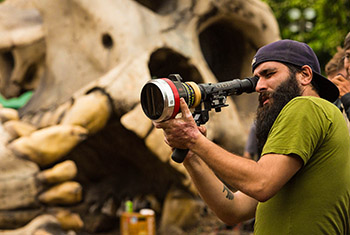 Director Jordan Vogt-Roberts. Photo courtesy of Warner Bros. Pictures. © 2017 WARNER BROS.ENTERTAINMENT INC., LEGENDARY PICTURES PRODUCTIONS, LLC AND PATPAC-DUNE ENTERTAINMENT LLC. ALL RIGHTS RESERVED
Director Jordan Vogt-Roberts. Photo courtesy of Warner Bros. Pictures. © 2017 WARNER BROS.ENTERTAINMENT INC., LEGENDARY PICTURES PRODUCTIONS, LLC AND PATPAC-DUNE ENTERTAINMENT LLC. ALL RIGHTS RESERVEDThe creative behind-the-scenes team included director of photography Larry Fong (“Batman v Superman: Dawn of Justice”), production designer Stefan Dechant (supervising art director “True Grit,” “Avatar”), Oscar-nominated editor Richard Pearson (“United 93,” “The Bourne Supremacy”), costume designer Mary Vogt (the “Men in Black” films), and composer Henry Jackman (“Captain America: Civil War”). The team also included Oscar-winning makeup supervisor Bill Corso (“Lemony Snicket’s A Series of Unfortunate Events,” “Star Wars: The Force Awakens”) and supervising stunt coordinator George Cottle (“Interstellar,” “The Dark Knight Rises”). The legendary Kong was brought to life at a whole new scale by Industrial Light & Magic, with two-time Oscar winner Stephen Rosenbaum (“Avatar,” “Forrest Gump”) serving as visual effects supervisor, and Oscar-nominee Jeff White (“The Avengers”) as visual effects supervisor. To fully immerse audiences in the mysterious Skull Island, director Jordan Vogt-Roberts and his cast and filmmaking team filmed across three continents over six months, capturing its primordial landscapes on Oahu, Hawaii, on Australia’s Gold Coast, and finally in Vietnam, where filming took place across multiple locations, some of which have never before been seen on film. Warner Bros. Pictures/Legendary Pictures and Tencent Pictures present a Legendary Pictures Production, a Jordan Vogt-Roberts Film, “Kong: Skull Island.” The film will be released worldwide in 2D, 3D in select theatres, and IMAX and will be distributed by Warner Bros. Pictures, a Warner Bros. Entertainment Company. This film has been rated PG-13 for intense sequences of sci-fi violence and action, and for brief strong language.
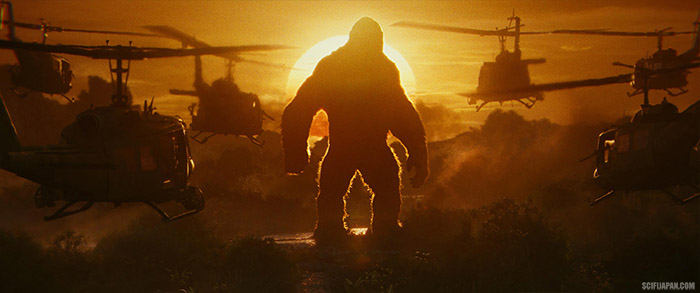 Photo courtesy of Warner Bros. Pictures. © 2017 WARNER BROS.ENTERTAINMENT INC., LEGENDARY PICTURES PRODUCTIONS, LLC AND PATPAC-DUNE ENTERTAINMENT LLC. ALL RIGHTS RESERVED
Photo courtesy of Warner Bros. Pictures. © 2017 WARNER BROS.ENTERTAINMENT INC., LEGENDARY PICTURES PRODUCTIONS, LLC AND PATPAC-DUNE ENTERTAINMENT LLC. ALL RIGHTS RESERVEDABOUT THE PRODUCTION
ALL HAIL THE KING Larger than life. Last of his kind. King of Skull Island. First unleashed more than eight decades ago, King Kong has thundered off the big screen and into our world with a force that echoes through our collective consciousness still. Now the time has come to restore the crown of the greatest movie monster myth of all. “Kong represents all the mystery and wonder that still exists in the world,” says “Kong: Skull Island” director Jordan Vogt-Roberts. “That’s why he will never stop being relevant.” The quest to reimagine cinema’s mightiest ape would reunite the producing team behind the 2014 blockbuster “Godzilla.” For Thomas Tull, who produced the film together with Mary Parent, Jon Jashni and Alex Garcia, it was a prospect both thrilling and incredibly daunting. “We wanted to create a fresh, new experience for the audience,” Tull offers. “As fans ourselves, it was incredibly important to us that we honor the essential elements of this character that have connected with so many people around the world in a big, fun, epic adventure that delivers the pure entertainment and spectacle of an action-packed monster movie.”
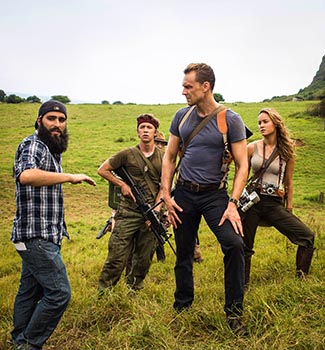 Jordan Vogt-Roberts with actors Thomas Mann, Tom Hiddleston and Brie Larson on location. Photo courtesy of Warner Bros. Pictures. © 2017 WARNER BROS. ENTERTAINMENT INC., LEGENDARY PICTURES PRODUCTIONS, LLC AND PATPAC-DUNE ENTERTAINMENT LLC. ALL RIGHTS RESERVED
Jordan Vogt-Roberts with actors Thomas Mann, Tom Hiddleston and Brie Larson on location. Photo courtesy of Warner Bros. Pictures. © 2017 WARNER BROS. ENTERTAINMENT INC., LEGENDARY PICTURES PRODUCTIONS, LLC AND PATPAC-DUNE ENTERTAINMENT LLC. ALL RIGHTS RESERVEDThe legend and iconography of Kong continue to strike consistently deep yet wildly varying chords with generations of fans. “A lot of things define Kong—his size, his power, his animal nature, but also his heart and huge depth of soul,” observes producer Mary Parent. “He keys into our natural affinity for other primates, and his gestures and expressions are much more humanlike than even natural primates—which is what has always set Kong apart from other monsters. Even though he’s a terrifying predator, it’s impossible not to root for him. In some ways, he’s been more like the classic romantic hero than a villain.” Kong is the seminal big-screen badass, and continues to resonate as everything from a living tempest of nature’s fury to an avatar for our own primal selves. Actor Tom Hiddleston suggests, “Kong embodies the internal clash between our civilized selves and the place in our consciousness that still has a very real sense of something bigger than ourselves. How do you reconcile this massive creature who is both a terrifying force of nature and a sentient being with an intelligence that is different from ours but no less sophisticated?” King Kong was originally conjured by revolutionary special effects master Willis H. O’Brien and sculptor Marcel Delgado to be the enigmatic central figure and unquestionable heart of Merian C. Cooper and Ernest B. Schoedsack’s groundbreaking 1933 classic “King Kong”—a dazzling mash-up of Beauty and the Beast, high adventure and giant monsters that would shock and awe millions of moviegoers across the world. It played to sold-out crowds at the height of the Great Depression and broke records through decades of re-releases and television airings. It was the original effects-driven blockbuster and monster movie milestone, and has been remade, parodied and spun-off on every sized screen. Kong has also become embedded in pop culture, inspiring everything from video games to hip hop lyrics to college dissertations, and deploying armies of action figures, models, toys and games. Kong’s defiant end from high atop the Empire State Building is among the most iconic of all time. But for fans—and Tull counts himself among them—his provocative beginning remains the Holy Grail of origin stories. In fact, his long-held goal of a 21st century MonsterVerse wouldn`t be complete without it. The producers brought in writers Dan Gilroy, Max Borenstein and Derek Connolly to craft the screenplay from a story by John Gatins. Tull states, “One of the most fascinating elements of the Kong lore is Skull Island—a place with the most exotic, lethal food chain you can imagine, and Kong is the alpha predator keeping the rest at bay. That’s the mythology we wanted to crack open in this film. Our characters are not taking Kong off the island. They have to survive his domain.”
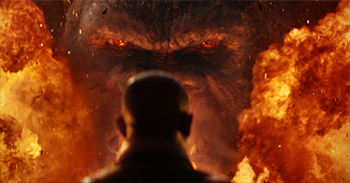 Photo courtesy of Warner Bros. Pictures. © 2017 WARNER BROS.ENTERTAINMENT INC., LEGENDARY PICTURES PRODUCTIONS, LLC AND PATPAC-DUNE ENTERTAINMENT LLC. ALL RIGHTS RESERVED
Photo courtesy of Warner Bros. Pictures. © 2017 WARNER BROS.ENTERTAINMENT INC., LEGENDARY PICTURES PRODUCTIONS, LLC AND PATPAC-DUNE ENTERTAINMENT LLC. ALL RIGHTS RESERVEDSamuel L. Jackson, who plays Lt. Colonel Preston Packard, the human alpha among the film’s characters, relishes the notion. “We want to see Kong in an environment that is as big and spectacular as he is,” says the acting legend. “We know he lives in the jungle, but what else is in that jungle? What’s out there that allows him to exist? Are there others or is he an anomaly? And we find out that he was once part of a community that got wiped out by something else that’s on that island. Now he’s the guardian that keeps those things in check.” With “Kong: Skull Island”—and “Godzilla” before it—the producing team is laying the foundation for a vast, shared universe of monsters, one grounded in our own world but heightened to allow for the existence of MUTOs (Massive Unidentified Terrestrial Organisms, in the “MonsterVerse” vernacular). But to do it justice meant not only orchestrating the collision of two longstanding cinematic mythologies but merging two distinct timelines. The key came in the form of a game-changing idea from Vogt-Roberts, an emerging filmmaker with just one feature under his belt—the acclaimed independent hit “The Kings of Summer.” Producer Alex Garcia reveals, “The linchpin of our Godzilla story is the notion that the 1954 nuclear tests weren’t tests; the government was actually trying to kill something. Jordan came in the door with the idea of setting the film in the 1970s, and that immediately lit up our imaginations. Not only did the `70s jibe with the MonsterVerse, it’s a rich period to explore thematically and allowed us to bring ultra-real warfare and giant monsters together within the same movie.” For Vogt-Roberts, “King Kong” had been the entrée to a lifelong obsession with film. “‘King Kong’ is legitimately film history, and when I first saw the 1933 film, it completely shattered my brain with its endless cinematic possibilities,” he says. “It was the first movie to transport audiences to an uncharted, untamed world. Though it was on our own planet, we were confronted with things that we were told couldn’t exist here.” A self-described “nerd,” the Detroit-born filmmaker came of age on a steady diet of monster movies, summer blockbusters and video games. His discovery of ‘70s cinema would be the flashing neon sign guiding him forward into making movies of his own. Though that generation’s bold, brash, socially conscious films had been produced long before Vogt-Roberts was even born, they spoke directly to his own contemporary experience and sensibility. “The ‘70s are like a weird black mirror of our modern world,” he notes. “Everything that was happening then—political scandals, civil unrest, divisive wars, distrust of the government—reflects exactly what’s happening right now. At the same time, the `70s was kind of the last time when science and myth could co-exist. Since then, we’ve been on a slow quest to destroy the unknown.” By colliding Cooper and Schoedsack’s lost world of monsters into a chaotic era of choppers, napalm and rock n’ roll, then dropping the audience directly into the fray, Vogt-Roberts hoped to bring all the power and relevance of Kong to today’s moviegoers. “I want this film to take people out of their comfort zone and thrust them into a balls-to-the-wall adventure that is visceral, intense and like nothing they’ve ever seen before. I’m pretty sure you won’t find a gigantic ape-like creature punching a Huey helicopter in another movie,” he smiles, “but that was the movie I wanted to see.” Moving the story from the 1930s to a more modern, but not modern-day, setting folded seamlessly into the themes the filmmakers were already exploring. Hiddleston, who had signed on to play the film’s disillusioned SAS vet Captain James Conrad prior to the director coming aboard, states, “It’s a world before the tyranny of global satellites, near total surveillance and information overload. We didn’t have the illusion—as we do today with the internet and cell phones and GPS—that we knew everything about the world we live in. The period setting also gave us an extraordinary prism to explore what Kong might represent in a conversation about war, and the tendency of mankind to destroy what he doesn’t understand.”
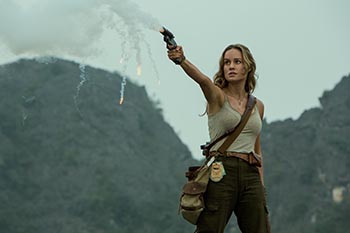 Photo courtesy of Warner Bros. Pictures. © 2017 WARNER BROS.ENTERTAINMENT INC., LEGENDARY PICTURES PRODUCTIONS, LLC AND PATPAC-DUNE ENTERTAINMENT LLC. ALL RIGHTS RESERVED
Photo courtesy of Warner Bros. Pictures. © 2017 WARNER BROS.ENTERTAINMENT INC., LEGENDARY PICTURES PRODUCTIONS, LLC AND PATPAC-DUNE ENTERTAINMENT LLC. ALL RIGHTS RESERVEDFor Brie Larson, who plays wartime photojournalist Mason Weaver, this dynamic gave the cast rich thematic territory to explore in their search for monsters. “To me, this story feels like an allegory for the animal nature that’s within us all,” she remarks. “We’re so far removed now from that part of ourselves; we seem to feel the need to overcome it in so many ways. It also taps into the ways we deal with the world around us—how we treat nature and how we value it, and how we value other human beings as well.” The year 1973 not only marked the end of the Vietnam War but the dawn of the Landsat program, when NASA began mapping the globe from space, which gave the filmmakers a credible hook for Kong’s exotic home to be discovered. “But,” producer Jon Jashni comments, “Skull Island is a place where human arrogance can perhaps be your undoing, if you don’t look before you leap.” Though Kong is the alpha on the island, he’s not the most vicious or terrifying thing in that order…by far. “Skull Island has been completely closed off from the rest of the world, and followed its own unique and bizarre evolutionary path,” Garcia says. “It’s extraordinarily beautiful but also the most dangerous place on Earth, with creatures unlike any we’ve encountered. This is no place for human beings, and their very presence, in fact, will have a profound effect on this delicate ecosystem.” Vogt-Roberts plunged into mapping the island’s dramatic shifts in feel and temperament and the effect each wonder and terror has on the characters and their choices. “One of the most amazing things we’ve done as human beings is to remove ourselves from the food chain,” he notes. “These characters come to Skull Island with all the presumptions of our place in the outside world and suddenly none of that matters…because they’re back in the food chain. I wanted to explore what that would do to people: Who breaks? Who becomes stronger because of it? Who rallies together?” Those questions, the director adds, are the fulcrum upon which “Kong: Skull Island” spins. “I love the idea of taking a handful of characters that have come out of the Vietnam War not believing in anything or quite knowing where they belong and thrusting them into this mystical place. Kong is not just a giant animal in our film. This isn’t a man versus nature story. That’s why our Kong will be the biggest in Hollywood history—I want audiences to feel what it’s like to look up and see something conscious and ferocious and 100-feet tall looming over you.”
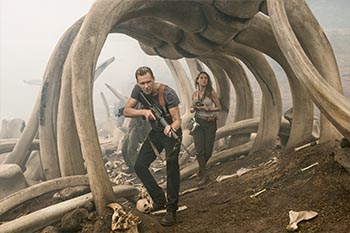 Photo courtesy of Warner Bros. Pictures. © 2017 WARNER BROS.ENTERTAINMENT INC., LEGENDARY PICTURES PRODUCTIONS, LLC AND PATPAC-DUNE ENTERTAINMENT LLC. ALL RIGHTS RESERVED
Photo courtesy of Warner Bros. Pictures. © 2017 WARNER BROS.ENTERTAINMENT INC., LEGENDARY PICTURES PRODUCTIONS, LLC AND PATPAC-DUNE ENTERTAINMENT LLC. ALL RIGHTS RESERVED“Kong: Skull Island” will bring moviegoers face-to-face with a living mountain of majesty and sheer force. But his mammoth stature is not the only thing the filmmakers are changing up. Parent explains, “Kong is an adolescent when we meet him in the film; he’s still growing into his role as alpha. And this is an island teeming with far more vicious creatures, including the Skullcrawlers, which killed his ancestors and made him last of his kind. That’s what’s so exciting about exploring this piece of the mythology. Kong is such a compelling figure anyway, but he’s facing the defining battle of his life in this film—the fight to claim his rightful place as King of Skull Island.” The quest to immerse today’s audiences in Skull Island would hurl cast and crew across the globe to some of the most intoxicatingly beautiful and exotic locales ever put on film. Vogt-Roberts offers, “When you’re bringing a myth to the screen not as a symbol but in the flesh, it’s critical to place him in an environment that feels tactile, real and absolutely alive. So it was incredibly important to shoot the film practically in environments the actors can interact with, as opposed to putting them on a green screen stage. I want people to look up at the screen and say, ‘I believe that could exist.’” The production of “Kong: Skull Island” spanned three continents—with locations in Australia, Hawaii and Vietnam—to capture footage that would later be seamlessly fused together to create a never-before-seen world. The first major feature film to shoot extensively in Vietnam, it entailed a complex logistical operation to open up the pristine environments in northern Vietnam for filming and to safeguard the ecology before, during and after principal photography. To bring the film’s seminal title character thundering back to the screen, Vogt-Roberts drew together an A-team of behind-the-scenes collaborators, who would push the envelope on design and effects, and raise the bar on digital character creation. “Kong: Skull Island” marked only the second film—and by far the biggest—that Vogt-Roberts has made, but he was undaunted. He reflects, “What guided me through this epic journey was to create an experience for the audience that will feel so real that it will open up a space for myth and mystery in their lives. Even though we’re making a completely new movie with, with a very different narrative…this is King Kong.”
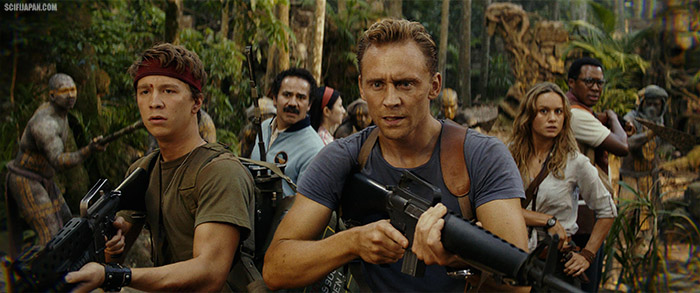 Thomas Mann as Slivko, John Ortiz as Victor, Tom Hiddleston as James Conrad and Brie Larson as Mason Weaver. Photo courtesy of Warner Bros. Pictures. © 2017 WARNER BROS.ENTERTAINMENT INC., LEGENDARY PICTURES PRODUCTIONS, LLC AND PATPAC-DUNE ENTERTAINMENT LLC. ALL RIGHTS RESERVED
Thomas Mann as Slivko, John Ortiz as Victor, Tom Hiddleston as James Conrad and Brie Larson as Mason Weaver. Photo courtesy of Warner Bros. Pictures. © 2017 WARNER BROS.ENTERTAINMENT INC., LEGENDARY PICTURES PRODUCTIONS, LLC AND PATPAC-DUNE ENTERTAINMENT LLC. ALL RIGHTS RESERVEDWE DON’T BELONG HERE: THE CAST The filmmakers drew together a stellar ensemble of actors to embody the film’s diverse characters and chart their individual journeys against the immense canvas of Skull Island. Leading the cast are Tom Hiddleston, Samuel L. Jackson, John Goodman, Brie Larson and John C. Reilly, along with Jing Tian, Toby Kebbell, John Ortiz, Corey Hawkins, Jason Mitchell, Shea Whigham, Thomas Mann, and Marc Evan Jackson. “I wanted to tell a human story within all this spectacle, and was incredibly fortunate to have such an insanely gifted, committed cast as my partners in that endeavor,” Vogt-Roberts states. “The actors brought so much of themselves to the film, and were fearless about finding those spontaneous moments that just elevated the film—making every moment funnier or scarier, or just more raw and real.” “Jordan conceived this film in a very brave, bold and original way, and was so inclusive of all the actors on this film,” says Hiddleston. John C. Reilly, who plays castaway Hank Marlow, adds, “Jordan is completely unflappable. He had the weight of this huge production on his shoulders and he’d just roll in like he was making an independent movie. He allowed us to make discoveries and explore fresh ideas, and that says a lot on a movie like this.” “Kong: Skull Island” opens in 1973, when times are changing, wars are being lost, and old beliefs are going down in a burst of gunfire, napalm and rock n’ roll. Mankind has claimed and tamed every inch of the known world, and NASA has launched a lone satellite into space to hunt down whatever’s left of the “Great Unknown”—charting the planet from space for the first time in human history. As Landsat 1 tracks over a violent geothermal disturbance in the South Pacific, its lenses and sensors detect solid ground cloaked within. To NASA, the skull-shaped island is just another landmass…notorious only for the number of ships and planes that go missing in its vicinity.
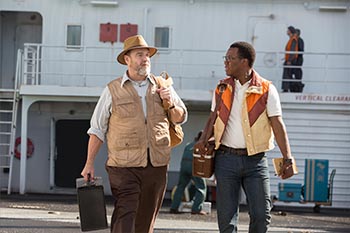 John Goodman as Bill Randa and Corey Hawkins as Houston Brooks. Photo courtesy of Warner Bros. Pictures. © 2017 WARNER BROS.ENTERTAINMENT INC., LEGENDARY PICTURES PRODUCTIONS, LLC AND PATPAC-DUNE ENTERTAINMENT LLC. ALL RIGHTS RESERVED
John Goodman as Bill Randa and Corey Hawkins as Houston Brooks. Photo courtesy of Warner Bros. Pictures. © 2017 WARNER BROS.ENTERTAINMENT INC., LEGENDARY PICTURES PRODUCTIONS, LLC AND PATPAC-DUNE ENTERTAINMENT LLC. ALL RIGHTS RESERVEDOnly senior Monarch operative Bill Randa, played by John Goodman, suspects what that storm has been hiding for millennia. Formed in the mid-‘50s as the government’s response to the atomic “tests” at Bikini Atoll—or, more precisely, the target of those tests—Monarch has been losing credibility in the decades since. By the early ‘70s, what Thomas Tull calls the “CIA of the MonsterVerse” is hanging by the thin thread of Randa’s relentless belief that we need to find every MUTO so they don’t find us first. And the Landsat satellite has just transmitted his best shot at getting the proof he needs to keep up the search. “Randa has been looking for Skull Island for 30 years,” Goodman explains. “So, with a little help from the Nixon Administration, he puts together a team to piggyback on this Landsat mission, ostensibly to look for rare earth elements or whatever resources they can find in the understrata of the island. That’s what he’s told people, anyway,” he chuckles. The geologist he recruits straight out of Yale University just happens to have written a controversial yet scientifically sound paper on the theory—some would say conspiracy theory—about the Hollow Earth. Corey Hawkins, who plays Ivy Leaguer Houston Brooks, says, “He’s written intelligently about the Hollow Earth, but, to Houston, it’s just a theory. He’s a skeptic. Quite honestly, Houston probably thinks Randa is crazy, but he’s a young black man in the ‘70s and sees this as a stepping stone.” Already on the Monarch staff is San, a brilliant biologist whose potent work tracking anomalies in the jungles of Brazil immediately caught Randa’s attention. Cast in the role, Jing Tian shares, “San has been studying the existence of these creatures through her work and knows going in what they might find on Skull Island. Even though they come from different angles, Brooks and San are a great team and look out for each other on this journey. That dynamic came really naturally with Corey, who is such a gifted actor.” Both young actors were thrilled to work with acting veteran Goodman. “He was game for anything,” Hawkins remembers. “During filming, we were hiking up a hill and I asked him, ‘John, why are you here doing this?’ He said, ‘Because I’ve never done it before.’” As the Landsat crew gears up for what they believe will be a textbook survey to gauge the accuracy of their satellites, Randa is gearing up for an adventure that could get all of them killed. To navigate and read the raw, unmapped terrain and detect what he firmly believes exists on Skull Island, they’ll need a tracker. And he knows where to find the best: face-down in a Saigon gambling den.
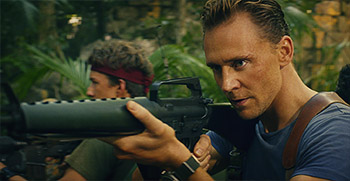 Photo courtesy of Warner Bros. Pictures. © 2017 WARNER BROS.ENTERTAINMENT INC., LEGENDARY PICTURES PRODUCTIONS, LLC AND PATPAC-DUNE ENTERTAINMENT LLC. ALL RIGHTS RESERVED
Photo courtesy of Warner Bros. Pictures. © 2017 WARNER BROS.ENTERTAINMENT INC., LEGENDARY PICTURES PRODUCTIONS, LLC AND PATPAC-DUNE ENTERTAINMENT LLC. ALL RIGHTS RESERVEDTom Hiddleston plays Captain James Conrad, a former SAS black ops officer, whom the actor describes as “kind of lost in Asia when Randa finds him, unwilling or unable to go home.” Nonetheless, Conrad is formidable. During the Vietnam War, he had trained both American and South Vietnamese troops in jungle warfare and was sent into wild and war-torn terrain to find and extract soldiers who’d been lost. “I’ve always been fascinated by human beings who endure the greatest extremities of nature, and that’s Conrad,” Hiddleston says. Cast a year and a half before cameras rolled on “Kong: Skull Island,” the actor dove into research and uncovered a little known aspect of the war that would become the backbone of this disillusioned adrenaline junkie. “England never officially entered the war, but digging around, I found out that British Special Forces had secretly been deployed to Cambodia or Indonesia to train the Americans and South Vietnamese because of their expertise in jungle warfare,” the actor explains. “So, it was thrilling for me to have the chance to collaborate with Jordan and the producers in shaping who this character was and where he is as he embarks on an adventure that will essentially challenge everything he does, or doesn’t, believe in.” Like Conrad, Mason Weaver, is another outsider who joins the team. But with a key difference. Brie Larson, who plays the role, explains, “Weaver doesn’t get offered the job; she kind of pulls the wool over people’s eyes to get on this mission because her gut tells her there’s more to it than she’s being told.” Though Weaver has a unique connection with Kong, she is not the film’s damsel in distress; nor is she the classic Beauty to Kong’s Beast. A street-smart investigative photojournalist, Weaver comes to the mission after braving some of the most dangerous combat zones and hotspots in the war. “She has a hard-earned reputation for being fearless and willing to do whatever it takes to expose the truth,” Larson affirms. “That passion has gotten her into trouble because a lot of publications—and the men captured in her lens—aren’t so crazy about seeing the dark side of the war held up to the light. Another dimension of her is that in the ‘70s, the battlefield was a very masculine place, and this was a chance to pay respect to the women who really did do this job in that world and are still doing it today.” A self-described “anti-war photographer,” Weaver does not carry a gun, shooting only with her trusty Leica. With her own background in photography, Larson had a frame of reference going in but became fully versed in the vintage camera. “I took a lot of photos on set and really started to see the world through Weaver’s eyes,” she says. “You’re trying to catch the moment between the moments, and you start seeing people differently.” With Randa pulling strings in Washington, the Landsat team suddenly finds its mission to chart the South Pacific landmass prioritized, well-funded and given a full complement of military support. “Landsat has never had access to anything like that,” says John Ortiz, who plays the Landsat survey team leader Victor Nieves. “It definitely makes them question the real reason that Monarch is along for the ride…and they are not prepared for what that is.” The military unit leading the airborne survey of the island is led by Lt. Colonel Preston Packard, who had proudly served in Vietnam and was firmly committed to winning it; however the U.S. government had other plans. When Packard is offered the assignment to accompany the Landsat expedition, he’s told it will be an easy paycheck for his seasoned team, called the Sky Devils. Just take them in, bring them back, and go home. Piece of cake.
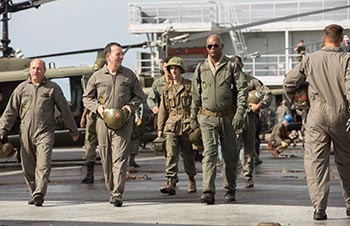 Samuel L. Jackson as Preston Packard. Photo courtesy of Warner Bros. Pictures. © 2017 WARNER BROS.ENTERTAINMENT INC., LEGENDARY PICTURES PRODUCTIONS, LLC AND PATPAC-DUNE ENTERTAINMENT LLC.
Samuel L. Jackson as Preston Packard. Photo courtesy of Warner Bros. Pictures. © 2017 WARNER BROS.ENTERTAINMENT INC., LEGENDARY PICTURES PRODUCTIONS, LLC AND PATPAC-DUNE ENTERTAINMENT LLC.Samuel L. Jackson, who plays the role of the battle-hardened soldier, relates, “Packard is glad that all his men are going home safe, but seizes the opportunity for them to have one last flight together before it’s time to go. People are saying we lost the war and he’s saying we just abandoned it. He wants his soldiers to feel like winners, and sees this as an opportunity for them to be heroes and come home with some kind of victory.” The core team of actors playing Packard’s loyal, tough-as-they-come Sky Devils are Toby Kebbell, Jason Mitchell, Shea Whigham, Thomas Mann and Eugene Cordero. Vogt-Roberts hand-picked the group to reflect the reality of the men and boys sent off to fight and perhaps never come home from Vietnam. The director comments, “They came from all walks of life, young and old, and these actors brought so much truth to the human side of war.” In addition to their physical and military preparation, the actors were able to spend time with real veterans from various wars, including Vietnam. “I’ve got kind of a baby face and when I first talked to Jordan, I remember thinking, ‘There’s no way I could have been a pilot in Vietnam,’” recalls Mitchell, who plays Warrant Officer Glen Mills, the young jokester of the Sky Devils. “The truth is that a lot of these pilots were 19 or 20 years old. For me, knowing these guys were that young just adds a whole other layer of fear, and of courage, and I wanted to honor that with Mills.” Adds Kebbell, who plays Packard’s trusted brother-in-arms, Major Jack Chapman, “They told us, ‘As a helicopter pilot, nobody is unhappy to see you. In the entire army, you are literally the only person that everyone—apart from the enemy—is happy to see. You’re caretakers.’ And that just gave us a bravado, and a real depth and understanding of who the Sky Devils are. We were so lucky to get to talk to those men.” To solidify the squad, the actors spent as much time as they could together during production, whether to rehearse, improv their characters, or just hang out. “I feel like we really did find that bond of brotherhood,” says Cordero, who plays Sergeant Joe Reles. “It’s that sense of, ‘You really bug me sometimes’; ‘I love you forever’; and then, when it really matters, ‘Nothing better happen to you!’ Everybody becomes your little brother, and it was so easy to get into that mindset with these guys.” With the combustive mix of Landsat crew, Monarch scientists, Sky Devils, and the two self-directed free agents, Weaver and Conrad, aboard, the freighter Athena pushes as close to their destination as she can safely go. Getting any closer would mean risking being swallowed up by the treacherous reefs below and a churning black wall of thunderclouds, dust and magnetic forces dead ahead. Undaunted, Packard makes the command decision to go for it, and the group lifts off the freighter in a choreographed formation of Huey helicopters. What emerges on the other side of the clouds is a stunning, untouched, primeval Eden and a moment of sheer wonder for everyone soaring over it…until the seismic charges fall and set this paradise aflame. The human incursion into Skull Island has begun. And it is met by its impossibly huge, devastatingly powerful guardian.
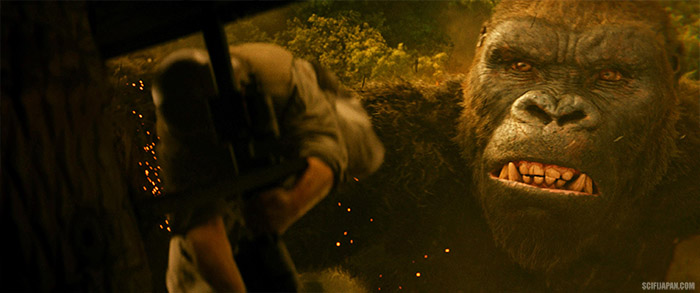 Photo courtesy of Warner Bros. Pictures. © 2017 WARNER BROS.ENTERTAINMENT INC., LEGENDARY PICTURES PRODUCTIONS, LLC AND PATPAC-DUNE ENTERTAINMENT LLC. ALL RIGHTS RESERVED
Photo courtesy of Warner Bros. Pictures. © 2017 WARNER BROS.ENTERTAINMENT INC., LEGENDARY PICTURES PRODUCTIONS, LLC AND PATPAC-DUNE ENTERTAINMENT LLC. ALL RIGHTS RESERVEDEven Randa is taken off guard. “He’s never seen anything like Kong,” Goodman attests. “They can’t tame him with technology or blind him with science, so immediately there’s a conflict.” As Packard watches in horror, “Kong knocks all these helicopters out of the sky, killing most of his men,” says Jackson. “Having left no man behind in Vietnam, and being the warrior that he is, he is not giving up on that fight easily. Having skin in the game and now blood on his hands for not getting his men home, his natural enemy becomes Kong.” But Conrad recognizes that they’re unmatched. “He sees the power of nature in Kong and his experience in the wild has taught him the futility of resisting,” notes Hiddleston. “It’s like shouting into a hurricane. A certain humility is necessary, and Conrad understands that immediately in a way that perhaps Packard, with all his weapons of war, doesn’t. But on this mission, even Conrad’s considerable experience and education is trumped by something new—something primordial and monolithic.” Decimated, stranded and divided amidst the charred debris fields that were once choppers, the survivors are left grappling with what they just saw. “We tell ourselves that we are gods of our domain,” Vogt-Roberts posits. “But when you look at this thing, all you can reason and reconcile is that you’re looking at a higher power. Whether they accept it, whether they fight it, or whether they just want to survive—that’s the path they all have to negotiate individually.” Larson agrees, “These characters all encounter the same thing, but as they go on this journey, their reactions run on two completely opposite tracks, from wanting to dominate it to feeling a connection and empathy for it. Kong is more than a force of nature—he is nature. We think we can dominate it, but matter how hard we try, nature always wins.” Like Kong, Packard is a force to be reckoned with... but not of nature. Separated from the military team, Weaver and Conrad, along with the Monarch scientists and one of Packard’s men, Warrant Officer Reg Slivko, search for the surviving Sky Devils and push toward their only chance of escape—the pre-set extraction site on the north side of the island. Cast as Slivko, Mann says, “Being separated from his unit and now on this journey with people whose mindset is very different from Packard’s definitely takes Slivko down a separate path from his brothers. He’s also still a kid in some ways, and can’t hide his wonder and terror.”
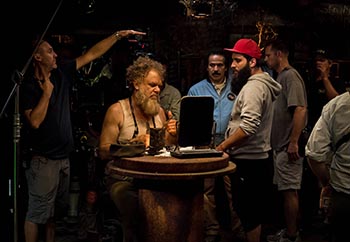 John C. Reilly, John Ortiz and director Jordan Vogt-Roberts. Photo courtesy of Warner Bros. Pictures. © 2017 WARNER BROS.ENTERTAINMENT INC., LEGENDARY PICTURES PRODUCTIONS, LLC AND PATPAC-DUNE ENTERTAINMENT LLC. ALL RIGHTS RESERVED
John C. Reilly, John Ortiz and director Jordan Vogt-Roberts. Photo courtesy of Warner Bros. Pictures. © 2017 WARNER BROS.ENTERTAINMENT INC., LEGENDARY PICTURES PRODUCTIONS, LLC AND PATPAC-DUNE ENTERTAINMENT LLC. ALL RIGHTS RESERVEDWhile the characters are the only human interlopers on Skull Island, they’re not the only humans. Bracing themselves for encounters with the full array of the island’s wonders and terrors, the group is stunned as warriors from its indigenous tribe, the Iwis, silently materialize around them. Then, to their utter shock, a friendly—and decidedly American—face bursts forth: Hank Marlow, played by John C. Reilly. A World War II fighter pilot who crash-landed on Skull Island 28 years ago, Marlow has survived here ever since—all the while desperate to get back to his wife and the son he was never able to meet. “Hank Marlow is an amazing character,” Reilly states. “He is a man out of his time, but he’s also kind of out of his mind from being on the island for so long. He has gone through his 20s, his 30s, and his 40s pretty much cut off from everything he knows. I would go stir crazy after six months, let alone 28 years. Hank has probably gone mad, become sane, and gone mad all over again a dozen different times.” However, he did not start out alone. At the flameout of an intense aerial battle with a Japanese fighter pilot, Marlow finds himself facing the enemy pilot, Gunpei Ikari, played by Miyavi—triggering a hand-to-hand fight to the death. But everything changes when they’re confronted with a force greater than anything either has ever seen: Kong. “These two guys meet as committed warriors and want to kill each other, and then 28 years later, you learn that this beautiful thing happened,” Reilly explains. “They transcended the war and became brothers.” Marlow assimilated as best as he could with the Iwi people, and through them, came to understand Kong. “The Iwi have a symbiotic relationship with the Island,” Vogt-Roberts offers. “They understand the importance of Kong; if he gets taken out, there are forces on the island that will rise up and tip the balance between peace and total annihilation.” Reilly adds, “Kong lives above the ground and the devils exist below. Kong is the only thing keeping them at bay, which allows space on the island for a bunch of different forces to work in harmony. To the Iwi people, Kong is a god.” Hank’s warning of Kong’s integral, even sacred, role on the island escalates the imminent conflict between what Goodman calls the “alpha males of the island”—Packard, Conrad and Kong himself. When Packard’s unit reconnoiters with Conrad’s group, it becomes clear that the military leader’s vengeance is all-consuming and unrelenting—unswayed even by Marlow’s warning about what will emerge if Packard succeeds in killing Kong. “Of course Kong reacted the way he did,” Reilly contends. “As Hank tries to tell them, ‘You don`t go into someone`s home and start dropping bombs unless you`re picking a fight!’”
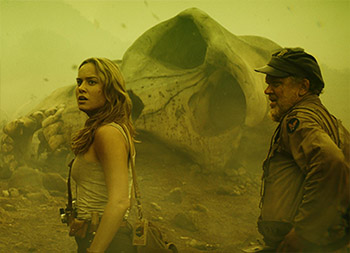 Photo courtesy of Warner Bros. Pictures. © 2017 WARNER BROS.ENTERTAINMENT INC., LEGENDARY PICTURES PRODUCTIONS, LLC AND PATPAC-DUNE ENTERTAINMENT LLC. ALL RIGHTS RESERVED
Photo courtesy of Warner Bros. Pictures. © 2017 WARNER BROS.ENTERTAINMENT INC., LEGENDARY PICTURES PRODUCTIONS, LLC AND PATPAC-DUNE ENTERTAINMENT LLC. ALL RIGHTS RESERVEDBoth Packard and Kong—each in his own way—is a protector: Kong of his home and Packard of his men, until Packard loses sight of what he’s protecting. “At this point, he has become almost an island unto himself,” Jackson observes. “Everyone is starting to understand that by exacting a measure of vengeance for the people he lost, even knowing that it risks the others not getting home, Packard is not being the level-headed commanding officer his soldiers have come to depend on all those years. In a rational world, and if he wasn’t so emotionally tied to the losses he suffered, he would understand the biological equation at play here. He still demands his pound of flesh.” “Packard has never let his guys down, and they would follow him anywhere” says Whigham, who plays Captain Earl Cole. “Cole is someone who follows orders, but the Colonel has begun to act from a very irrational place. So, he’s beginning to question his leadership and feeling the inherent confusion and sadness of no longer being sure what’s right.” Pursuing neither science nor dominance, Weaver becomes the first among their party to meet Kong face-to-face…and the first to see the true scope of what they have inadvertently set into motion. “Weaver’s encounter with Kong opens her heart to something greater than herself,” Larson reflects. “Kong is the biggest thing on the island, yet he doesn’t choose to use his power in a way that’s harmful to her. She starts this journey wanting to capture images that will get a lot of acclaim and maybe win prizes, but seeing into this being’s soul, she very quickly realizes that there’s something on this island that’s precious and needs to be protected.” Conrad’s own close encounter with the island’s majestic King reveals to him something he was seeking and didn’t even know it: redemption. “Conrad is scanning the territory from a high cliff, and then suddenly Kong’s face is a meter away, within touching distance,” Hiddleston details. “He knows he’s being seen by Kong and that he’s looking into the eyes of a sentient being, and it reopens his heart to wonder and innocence and humility. Conrad starts this journey from a place of cynicism -- a soldier taking an easy paycheck. He was sleepwalking through his life, but now he’s fully awake.”
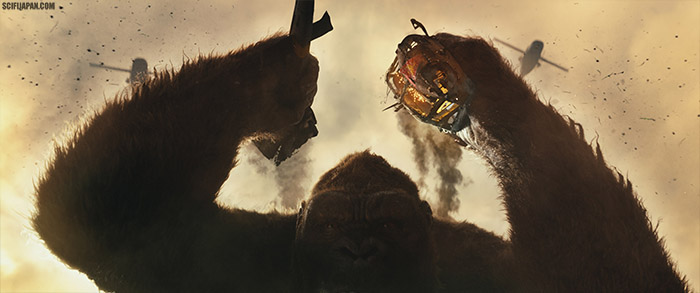 Photo courtesy of Warner Bros. Pictures. © 2017 WARNER BROS.ENTERTAINMENT INC., LEGENDARY PICTURES PRODUCTIONS, LLC AND PATPAC-DUNE ENTERTAINMENT LLC. ALL RIGHTS RESERVED
Photo courtesy of Warner Bros. Pictures. © 2017 WARNER BROS.ENTERTAINMENT INC., LEGENDARY PICTURES PRODUCTIONS, LLC AND PATPAC-DUNE ENTERTAINMENT LLC. ALL RIGHTS RESERVEDTHE SOUND AND THE FURY: CREATING KONG For the filmmakers overseeing such a complex production, there was perhaps nothing more challenging or exhilarating than the creation of the title character. They certainly didn’t make things easy for themselves. “I always imagined Kong as being his own species and defying any simple characterization or comparison with the creatures of our world,” says Thomas Tull. Tull’s perspective was perfectly in sync with the director’s, whose iconic monster is like no other. Vogt-Roberts confirms, “In our film, Kong is a throwback to a classic movie monster, not just an ape. I wanted our Kong to be more of a lonely god than ever before. Then I wanted to slowly reveal that he has empathy and pathos and can connect with others on an emotional level. Even though in our film he is god-like, there’s humanity to Kong—a heart that I think people will respond to.” The effort to make Kong live and emote onscreen with as much detail and realism as possible involved a broad coalition of creative talents within the visual effects and animation teams, and specialists in concept art, sound and design, all unified through Vogt-Roberts’s vision for the character and his directive to think outside the box. Premier visual effects house Industrial Light & Magic, which has spearheaded VFX for some of the biggest blockbusters in cinema history, helped bring Kong to life on a whole new scale. They were led by senior visual effects supervisor Stephen Rosenbaum and visual effects supervisor Jeff White.
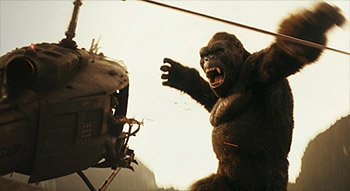 Photo courtesy of Warner Bros. Pictures. © 2017 WARNER BROS.ENTERTAINMENT INC., LEGENDARY PICTURES PRODUCTIONS, LLC AND PATPAC-DUNE ENTERTAINMENT LLC. ALL RIGHTS RESERVED
Photo courtesy of Warner Bros. Pictures. © 2017 WARNER BROS.ENTERTAINMENT INC., LEGENDARY PICTURES PRODUCTIONS, LLC AND PATPAC-DUNE ENTERTAINMENT LLC. ALL RIGHTS RESERVEDThe ILM team numbered almost 300 artists, animators and technicians, based in three separate facilities. ILM’s work on Kong took over a year and a half, eight months of which were spent designing the mythic figure. The principal task was to not only create a character with a presence and purpose, but to make him a powerful anti-hero as well. “Our inherent challenge was to have audiences feel an affinity for Kong and to imbue him with that element of humanity,” Rosenbaum explains. Vogt-Roberts kicked off the process by asking the ILM team to evoke the essence of the classic 1933 film “King Kong,” preserving its cultural mystique and classic monster feel. It was a demanding mandate but one all the filmmakers took to heart as bringing together the best of both worlds. This intersection of the epic and the intimate has produced some of the most visceral, original and pulse-pounding scenes in the history of the genre, as well as some unexpected, emotionally charged moments. White admits that some of his favorite scenes were the quieter moments where Kong connects to some members of the expedition team, or ponders Skull Island’s infinite beauty. “I particularly enjoyed scenes like when Kong is sitting quietly, gazing at the Aurora Borealis, interacts with Weaver to aid a stricken animal, and connects with Weaver and Conrad on a cliff side. I think those moments are when Kong really comes alive as a character.” The 1933 film also sparked ideas for specific aspects of the new Kong’s look. One of the industry’s most prominent creature designers, Carlos Huante, referenced posed frames from the earlier work, and then drew muscle and body shape details to create an anatomically updated physique. ILM continued to develop this design. “We kept pushing it further and further to recapture what has made Kong so impactful,” White offers. “We incorporated some of the exaggerated proportions of Kong’s muzzle, gave him a small crown and huge brow, as well as a richer, orange-brown coloring, and then lit Kong with strong side lighting to bring out the depth of those features.” But in this new version of Kong, size matters. A lot. At 100-feet tall, he towers over other iterations…and the new visitors to Skull Island. “That’s important because that dimension gives Kong weight and a grandiose quality, where a human will look like a speck in the shadow of this colossus, and you see how insignificant we are in his world, where we really don’t belong,” White elaborates. Kong’s mammoth presence was a key factor that led to Vogt-Roberts’s decision to create much of the character’s performance through traditional keyframe animation, led by ILM animation supervisor Scott Benza, instead of referencing a performance capture by a specific actor. Keyframe animation would also facilitate the director’s ability to work closely with the ILM animators to create the Kong performance he envisioned. Additionally, there was a facial capture session with Toby Kebbell, who also portrays Major Jack Chapman, and a motion capture session with Terry Notary, the acclaimed movement coach on films such as “Dawn of the Planet of the Apes” and “The Hobbit Trilogy.” Once the animation was finished, ILM built Kong’s underlying skeleton and muscle structure, and then simulated the movement of the muscles under his skin, as well as his hair reacting to the skin movement. Again, the 1933 film provided some inspirational performance cues. For example, the ILM animators gave Kong a wide-eyed roar, which Benza says has an inherent monster quality. “You would think he’d scrunch his eyes into a squinty shape when he’s angry, but we liked the eye shape from 1933.”
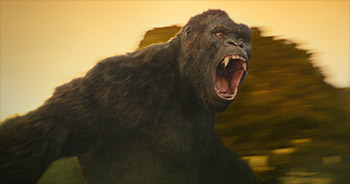 Photo courtesy of Warner Bros. Pictures. © 2017 WARNER BROS.ENTERTAINMENT INC., LEGENDARY PICTURES PRODUCTIONS, LLC AND PATPAC-DUNE ENTERTAINMENT LLC. ALL RIGHTS RESERVED
Photo courtesy of Warner Bros. Pictures. © 2017 WARNER BROS.ENTERTAINMENT INC., LEGENDARY PICTURES PRODUCTIONS, LLC AND PATPAC-DUNE ENTERTAINMENT LLC. ALL RIGHTS RESERVEDILM’s biggest technical challenge involved three things we see every day in the natural world: hair, water and fire. Individually, they are among the most difficult visuals to render via computer graphics. “Kong: Skull Island” has all three elements interacting. Kong’s mane itself was a monumental endeavor, with ILM spending an entire year hand-grooming, shaping and sculpting the beast’s 19 million hairs. “There’s no way to just generate it,” White emphasizes. “You actually have to tell the computer where the hairs should go and what they should look like.” The challenges of water simulation were escalated exponentially because ILM had to create it on a grand scale. “The water is all digital and responds to real physics, but Kong is so enormous and moves so quickly, his hand hits the water at 40 or 50 miles per hour,” White continues. “So out of the box the water simulations would shoot so high in the air that you couldn’t even see Kong. We had to figure out the right ‘cheats’ to make sure his face was visible, while still making it seem like the water was obeying the laws of physics.” Sound design was another important element in bringing Kong to life. Long before production commenced, the filmmakers experimented with different techniques to create Kong’s chilling, heartrending roar, as well as a whole universe of sounds that would give the action a visceral, theatre-shaking feel. Kong’s thunderous vocalizations were overseen by supervising sound editor / sound designer Al Nelson, who credits Vogt-Roberts with providing important context for Kong’s character beats. “Jordan’s ideas were more complex and richer than just making Kong sound bigger and louder than previous versions,” Nelson asserts. “He wanted Kong to be god-like—to be the absolute ruler of Skull Island. So instead of Kong being an angry, gnarly, gnashing, screaming creature, he is instead this majestic being in charge of this magical world. That kind of guidance really helped.” Nelson’s first stops in finding Kong’s voice were at the National Zoological Park in Washington, D.C., and Disney’s Animal Kingdom in Orlando, Florida, where he recorded our world’s kings of the jungle: lions. “The reason I recorded and used lions was that Kong was the first movie monster that was ‘sound designed,’” Nelson explains. “That was by Murray Spivak for the 1933 film. He used a lion roar and a reverse tiger roar -- supposedly recorded at the L.A. Zoo. I wanted to use the lion as a starting point because of this sound tradition.” In addition, Nelson used gorilla and monkey sounds, which he mixed and matched to create additional sonic layers for Kong.” Of course, there’s nothing in nature matching Kong’s island-shaking decibel levels. To fully capture it, the sound team rigged a special playback system at their home base at Skywalker Sound in Northern California. “We set up some speaker systems and did what we call ‘worldizing,’ where we played Kong’s bellows and roars through a 5.1-channel system to achieve a natural reverberation and echo, so we could lay them in a more environmental way,” Nelson relates.
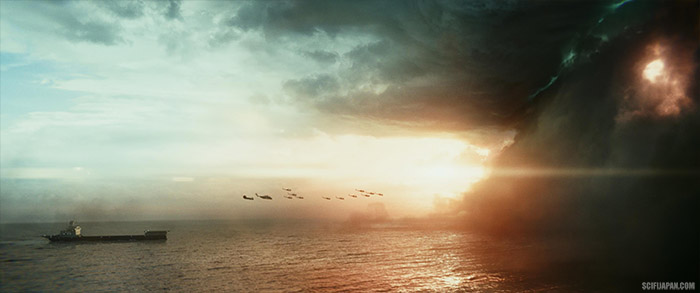 Photo courtesy of Warner Bros. Pictures. © 2017 WARNER BROS.ENTERTAINMENT INC., LEGENDARY PICTURES PRODUCTIONS, LLC AND PATPAC-DUNE ENTERTAINMENT LLC. ALL RIGHTS RESERVED
Photo courtesy of Warner Bros. Pictures. © 2017 WARNER BROS.ENTERTAINMENT INC., LEGENDARY PICTURES PRODUCTIONS, LLC AND PATPAC-DUNE ENTERTAINMENT LLC. ALL RIGHTS RESERVEDBUILDING KONG’S PRIMORDIAL DOMAIN The primordial domain over which Kong reigns is Skull Island, a sanctuary untouched by humans. It is a mix of wrath and beauty, and of the fantastical and real. “It has an amped-up ecosystem not found outside the island,” says Garcia. Adds Parent, “Early in the process, we fixed on the potential of Skull Island, which has its own weather system and otherworldly qualities. We aimed to show audiences something they haven’t seen before.” Production designer Stefan Dechant says Vogt-Roberts communicated a clear idea of the island they were creating. “This is Jordan’s world, and we treated it like he’s actually been to Skull Island, returned, and regaled us with stories about his trip,” he says. “Kong: Skull Island” was the first major motion picture to shoot extensively in Vietnam. Filming also took place on the Hawaiian island of Oahu and at several locations along Australia’s Gold Coast. Garcia remarks, “Shooting in Vietnam was such a huge asset for the production. The country has these incredibly distinct backdrops that you won’t see anywhere else. Meshing that with the scope we captured in Hawaii and Australia was thrilling.”
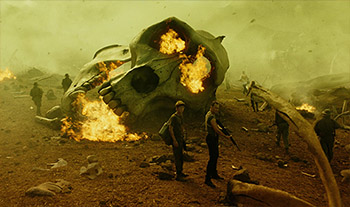 Photo courtesy of Warner Bros. Pictures. © 2017 WARNER BROS.ENTERTAINMENT INC., LEGENDARY PICTURES PRODUCTIONS, LLC AND PATPAC-DUNE ENTERTAINMENT LLC. ALL RIGHTS RESERVED
Photo courtesy of Warner Bros. Pictures. © 2017 WARNER BROS.ENTERTAINMENT INC., LEGENDARY PICTURES PRODUCTIONS, LLC AND PATPAC-DUNE ENTERTAINMENT LLC. ALL RIGHTS RESERVEDThe story of “Kong: Skull Island” provided the ideal aesthetic and a key piece of the puzzle in creating the seminal landscapes of the fictional Skull Island. “As soon as we landed there, I knew there was something really special about it,” Vogt-Roberts recalls. The production shot for three weeks at various locations in Vietnam, some of which had never before been captured in a feature film. Filming took place in Yen Phu, Tu Lan and Phon Nha Overlook; in Ninh Binh along the Tam Coc River, Trang An, and Van Long Marsh; culminating in the spectacular vistas of Ha Long Bay. Transporting cast, crew and the full complement of movie equipment into some of Vietnam’s most isolated provinces took a huge amount of planning and the deployment of a massive logistical operation, including building roads where none existed. After wrapping each location, the production fully restored its sometimes fragile ecology. Supervising location manager Ilt Jones was the self-described “protector of the environment,” ensuring that all locations were left in better condition than when he found them. Taking to heart Vogt-Roberts’s directive that Vietnam visually anchor the film’s locations, ILM’s Jeff White spent several weeks prepping there, flying around the country to capture aerial plates, which were then scanned. “We ended up using the material to not only augment the scenes shot in Vietnam, but to replace some environments captured in Hawaii, so that the backgrounds maintained a consistent feel,” he explains. “That was especially useful for some of the Hawaii locations that are so recognizable from other movies. We’d use the area around the actors and the plate, but replace the entire horizon with Vietnam’s mountains. That not only helps the film’s cohesiveness, it ensures that it’s moored in Vietnam.” Vogt-Roberts was left with a lasting appreciation for the country. “My hope is that audiences will fall in love with Vietnam and that our film inspires an understanding of its beauty. My experience there was life-changing. I fell in love with the culture and the people of Vietnam, and nothing would make me happier than for the rest of the world to see how incredible and strong the country is.” The wonders of Oahu, though more familiar, also provided exotic locales. Locations in the 50th state included historic Kualoa Ranch and Waikane Valley’s Ohulehule Forest Conservancy.
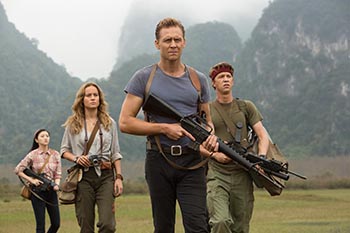 Photo courtesy of Warner Bros. Pictures. © 2017 WARNER BROS.ENTERTAINMENT INC., LEGENDARY PICTURES PRODUCTIONS, LLC AND PATPAC-DUNE ENTERTAINMENT LLC. ALL RIGHTS RESERVED
Photo courtesy of Warner Bros. Pictures. © 2017 WARNER BROS.ENTERTAINMENT INC., LEGENDARY PICTURES PRODUCTIONS, LLC AND PATPAC-DUNE ENTERTAINMENT LLC. ALL RIGHTS RESERVEDWhile Oahu’s Kualoa Ranch has become a magnet for contemporary film productions, its lush and diverse landscapes were virtually transformed to become the otherworldly backdrops for the characters’ trek across Skull Island. At the floor of a deep valley surrounded by towering peaks, the production created the island’s boneyard—an evocative wasteland littered with ghostly and massive remains. The boneyard, which was later extended to the horizon by the visual effects team, is a place dedicated to death and the extinct... but which is, in fact, very much alive. The setting provides intriguing and harrowing clues about Kong’s lineage. Dechant explains, “In previous stories, we never knew where Kong came from, or anything about his species or family. The boneyard is a way for us to see what happened to Kong and what had shaped him. We see the remains of his ancestors and of other creatures.” The special effects team, led by Mike Meinardus, also made key contributions to the set, creating explosions in the boneyard vents—“like those in a volcano,” he remarks—and bathing the location in thick, yellowish smoke, which oozes out from under the ground. For a sequence in which a vengeance-driven Packard draws on his Vietnam experience to set a trap—a lake laced with napalm that the character transforms into a mammoth inferno—Meinardus spearheaded the construction of a man-made lake, a portion of which would later be digitally extended. The SFX team rigged the lake with fire pipes and heptanes injector nozzles, from which flames as high as 60 feet roared to life. “We had 3500 hundred feet of propane hose and about 750 feet of fire piping, all of which were on manifolds,” Meinardus recounts. “We were in the middle of a jungle, so everything was carefully controlled, for safety as well as environmental protection.” Outside of the jungle, Conrad is introduced in a Saigon dive bar/gambling den, but Dechant recreated the Vietnam metropolis in Oahu’s Chinatown. According to Dechant, “Saigon is now very modern, and to capture the period flavor we needed, it made sense to film in Hawaii and create that illusion of ‘70s Saigon.” Sandwiched between the Oahu and Vietnam shoots, filming in Australia took full advantage of the country’s diverse locales. “The Gold Coast was fantastic because there are various environments available, including a desert, dense jungle and rocky outcroppings, as well as stage facilities and top-notch crews at Village Roadshow Studios,” says Garcia. The film’s biggest set is the rusting shell of the SS Wanderer, a derelict ship that long ago washed up on the shores of Skull Island, where it was turned into a shrine by the native Iwi tribe, who see it as a gift from the gods. On the studio soundstage, Dechant and director of photography Larry Fong collaborated to light this cathedral-like space primarily using the glow of candles and artificial sunbeams filtering through holes in the ship’s hull.
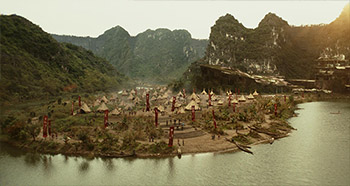 Photo courtesy of Warner Bros. Pictures. © 2017 WARNER BROS.ENTERTAINMENT INC., LEGENDARY PICTURES PRODUCTIONS, LLC AND PATPAC-DUNE ENTERTAINMENT LLC. ALL RIGHTS RESERVED
Photo courtesy of Warner Bros. Pictures. © 2017 WARNER BROS.ENTERTAINMENT INC., LEGENDARY PICTURES PRODUCTIONS, LLC AND PATPAC-DUNE ENTERTAINMENT LLC. ALL RIGHTS RESERVEDAdding to the shrine’s mystique is a series of pillars onto which images have been engraved. As the characters wind through it, additional wonders are revealed, hinting at a wider world of monsters and possibilities. ILM’s Jeff White details, “The sequence was designed for Marlow to give audiences a back story on Kong. We spent a considerable amount of time on the design of each graphic to make sure the story being communicated was clear, and then decomposed each engraving into the unique look of the Iwi language. It was important to Jordan that the pictures should look like a jumble at first and then be revealed as the characters’—and audiences’—perspective shifts. For each shot, we picked a frame where the image would assemble and then started shifting the CG pillars’ positions to make sure the graphic was not obvious at the start. It was an enormous design challenge but adds to the mystery and complexity of Skull Island.” The filmmakers embraced Australia’s astonishing landscapes, trekking out to the country’s Gold Coast hinterland to film on sites such as Tamborine Mountain, Tallebudgera Valley and the Paperbark Forest. The sand dunes of South Stradbroke Island provided the magnificent backdrop for the film’s opening sequence. But getting there, says Garcia, mirrored some of the scripted adventures. “We took a 30-minute boat ride through Jumpinpin Inlet; then a 40-minute ride down to the beach on dune buggies. At times it felt like being on the moon,” he laughs. Brie Larson drew on a past experience with an elephant for one of the few fully green screen sequences in the film—Weaver and Conrad’s first close encounter with Kong himself, filmed at Village Roadshow Studios. “Maybe it’s a stretch, but it’s the closest I’ve ever been to a creature that was that big and had that much power, but that chose to be gentle with me,” she muses. “I think there’s something wonderful about that. Kong is the biggest thing on the island, yet he doesn’t use his power in a way that’s harmful to them.” Nonetheless, the emotional scene made for a challenging day for the actors, who had to form a palpable connection with their enormous but invisible scene partner. Hiddleston improvised, suggesting they play an evocative piece of music—John Murphy’s “Adagio in D Minor” from the “Sunshine” film score—and gradually the scene came together. “There are very few moments where you say, ‘Okay, that was magic,’” shares Vogt-Roberts. “That scene happened to be one of those moments.”
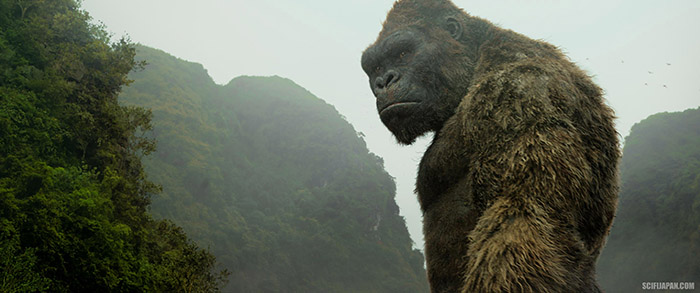 Photo courtesy of Warner Bros. Pictures. © 2017 WARNER BROS.ENTERTAINMENT INC., LEGENDARY PICTURES PRODUCTIONS, LLC AND PATPAC-DUNE ENTERTAINMENT LLC. ALL RIGHTS RESERVED
Photo courtesy of Warner Bros. Pictures. © 2017 WARNER BROS.ENTERTAINMENT INC., LEGENDARY PICTURES PRODUCTIONS, LLC AND PATPAC-DUNE ENTERTAINMENT LLC. ALL RIGHTS RESERVEDTHE DECADE OF KONG The filmmakers locked onto the year 1973 as a central component of their interpretation of the Kong myth. It was a time when the world seemed to be spinning out of control, due in no small part to the Vietnam War, which was finally drawing to a close, as well as other economic, social and political upheavals that rocked the decade. At the same time, it was a period that Vogt-Roberts says was “aesthetically awesome, with an infinite amount of beauty in its details.” Helping to capture that aesthetic were specially designed anamorphic camera lenses—the only ones of their kind—which Vogt-Roberts and Fong created in collaboration with Panavision. “The lenses have a kind of vintage feel to them, which worked well for us in capturing and pushing the ‘70s look we were going for,” says Fong. “Panavision told us these were the finest anamorphics they’ve ever made.”
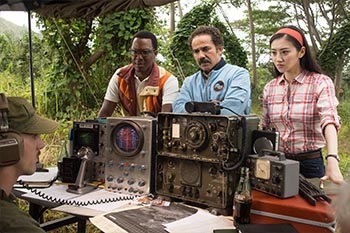 Photo courtesy of Warner Bros. Pictures. © 2017 WARNER BROS.ENTERTAINMENT INC., LEGENDARY PICTURES PRODUCTIONS, LLC AND PATPAC-DUNE ENTERTAINMENT LLC. ALL RIGHTS RESERVED
Photo courtesy of Warner Bros. Pictures. © 2017 WARNER BROS.ENTERTAINMENT INC., LEGENDARY PICTURES PRODUCTIONS, LLC AND PATPAC-DUNE ENTERTAINMENT LLC. ALL RIGHTS RESERVEDTo further set the visuals apart from other films, Fong and Vogt-Roberts made an early choice to feature unexpected colors in a vivid way, giving the film the feel of a Vietnam War fever dream. The decade also informs the world of the covert agents of Monarch, led by John Goodman’s Bill Randa, who work off an aircraft carrier, Athena, from which the expedition team helicopters to Skull Island. Huey helicopters—another iconic ‘70s mode of transport in both real and reel life—are also key players. The Huey’s signature airborne propeller sound of fwop, fwop, fwop—“one of our nerd sound terms,” jokes Al Nelson—is prominent in alluding to Packard’s internal struggles about the end of the war, as well as slow motion moments during Kong’s shocking confrontation with the choppers as they invade his home. To capture the fwop, sound designer Pete Horner, sound effects editors Benjamin A. Burtt, Pascal Garneau and William McGuigan, and supervising sound editor Steve Slanec, worked with the Vietnam Helicopters Museum in Concord, California, to record an actual Huey from that era. “The museum made a Huey available to us, and, armed with all sorts of microphones and other recording equipment, we stood underneath the blades, while they were spinning, to get that clean fwop, fwop, fwop,” says Horner. “It was thrilling. Then they flew us around in the Hueys, performing special maneuvers, the recordings of which can be heard in a scene where the Hueys fly into the horrific storms surrounding and protecting Skull Island.” For the period costumes, Vogt-Roberts and costume designer Mary Vogt opted for a classic ‘70s look, eschewing fashion trends of the period, like plaid shirts and extra-wide ties. “Our characters wear the same outfit for a long time, so we wanted the look to be real,” Vogt comments. To dress Hiddleston’s former Special Air Service operative, Vogt consulted a booklet about life in the SAS, penned by a former member of that elite Special Forces unit of the British army. “The booklet goes into a lot of detail about their missions, and how many days they’d go without a change of clothes,” Vogt explains. “So, we gave Tom a simple and heroic look, reminiscent of Steve McQueen’s in his films of that period, including pants with clean lines, boots, and a fitted shirt.” Samuel L. Jackson’s Packard sports a military-issue netted scarf, which not only protects him from bugs, but provides a kind of regal appearance. “It also sets Packard apart from the other members of his unit,” notes Vogt. In addition, property master Steven B. Melton made sure that each of Packard’s men had an authentic-looking helmet. “I bought 21 helmets on eBay, and we went through 300 different designs to get to the seven Jordan liked,” Melton says. “Each character’s helmet has different stickers and designs, some of them purchased from former Vietnam helicopter pilots.” Brie Larson’s Mason Weaver, a war photographer who was in country, wears lace-up boots, a pale gray shirt, and olive-drab pants, “giving her an almost military look,” says Vogt.
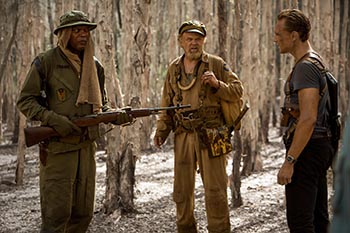 Photo courtesy of Warner Bros. Pictures. © 2017 WARNER BROS.ENTERTAINMENT INC., LEGENDARY PICTURES PRODUCTIONS, LLC AND PATPAC-DUNE ENTERTAINMENT LLC. ALL RIGHTS RESERVED
Photo courtesy of Warner Bros. Pictures. © 2017 WARNER BROS.ENTERTAINMENT INC., LEGENDARY PICTURES PRODUCTIONS, LLC AND PATPAC-DUNE ENTERTAINMENT LLC. ALL RIGHTS RESERVEDJohn C. Reilly’s Marlow is clearly not a man of the ‘70s, so Vogt gave the actor a World War II flyer’s cap, which Reilly liked and decided to wear through the entire shoot. “The flyer’s uniform is romantic and heroic,” says Vogt. Makeup supervisor Bill Corso points out that being marooned on an island for 30 years has taken its toll on Marlow. “It has made his face look like leather, and his beard had to look like he shaves with a Samurai sword…which in fact, he does.” The ‘40s also come into play with Marlow’s unlikely seafaring vessel, which becomes the expedition’s last hope for rescue from Skull Island. Built by Marlow and his onetime enemy and now deceased friend, Gunpei Ikari, it’s a kind of hybrid/hodgepodge craft built from cannibalized parts from Marlow’s P-51 and Gunpei’s Zero. Meinardus and team built the ship’s motor from scratch, and made it vibrate, smoke and shake, as well as the craft’s smokestack, which belches out black smoke. The island’s indigenous people, the Iwi, transcend time. Significantly, their fates are intertwined with Kong’s. Garcia explains, “The Iwi are isolated from the rest of the world. They are peaceful, and both simple and advanced. The Iwi have a symbiotic relationship with Skull Island, and they know that if Kong, the last of his kind, is taken out, the island’s delicate balance of nature will be destroyed.” Vogt-Roberts adds, “I wanted the Iwi to worship Kong, and in a way to be more evolved than the new visitors to Skull Island.” The intricately designed patterns painted onto the Iwi were more than just decorative. The complex body and facial artwork was inspired by an unlikely source. Vogt-Roberts, a longtime gamer, explains, “I was intrigued by the pixilated shapes of many videogame characters, with their hard edges and 90-degree angles. I liked the idea of creating something that felt anachronistic—that was both modern yet ancient. So we designed this paint pattern that served multiple purposes. You begin to understand that the paint itself also has their language written within it, as well as being camouflage, which allows them to navigate and blend into the island and stay alive amongst the innumerable threats surrounding them.”
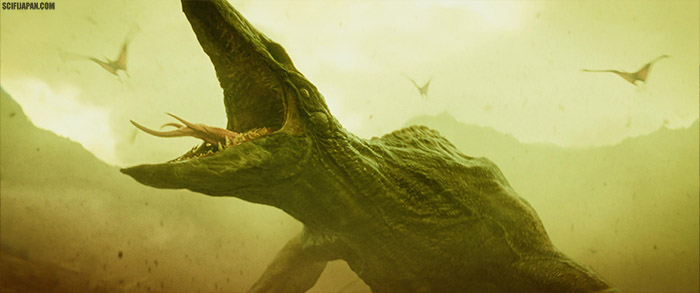 A Skullcrawler. Photo courtesy of Warner Bros. Pictures. © 2017 WARNER BROS.ENTERTAINMENT INC., LEGENDARY PICTURES PRODUCTIONS, LLC AND PATPAC-DUNE ENTERTAINMENT LLC. ALL RIGHTS RESERVED
A Skullcrawler. Photo courtesy of Warner Bros. Pictures. © 2017 WARNER BROS.ENTERTAINMENT INC., LEGENDARY PICTURES PRODUCTIONS, LLC AND PATPAC-DUNE ENTERTAINMENT LLC. ALL RIGHTS RESERVEDSTUNTS AND SKULLCRAWLERS For much of their journey, the expedition team members are hurled into battles and fights on a scale even Packard’s hardened G.I.s could never have imagined. In designing and executing the film’s propulsive action and epic set pieces, stunt supervisor George Cottle oversaw a team of 60 stunt performers, who rehearsed all the fights and wirework for eight weeks prior to the start of principal photography. The biggest challenge to the stunt team was the remote Vietnamese locations, some of which involved a 45-minute drive, a parade of four-by-four trucks and long hikes.
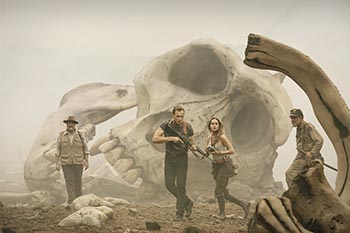 Photo courtesy of Warner Bros. Pictures. © 2017 WARNER BROS.ENTERTAINMENT INC., LEGENDARY PICTURES PRODUCTIONS, LLC AND PATPAC-DUNE ENTERTAINMENT LLC. ALL RIGHTS RESERVED
Photo courtesy of Warner Bros. Pictures. © 2017 WARNER BROS.ENTERTAINMENT INC., LEGENDARY PICTURES PRODUCTIONS, LLC AND PATPAC-DUNE ENTERTAINMENT LLC. ALL RIGHTS RESERVEDThe availability of certain equipment was as much an issue as the accessibility of some locations. For example, Cottle required a huge crane for a scene in which a principal character suddenly finds himself airborne. “There was only one crane we knew of in Vietnam, which involved a 12-hour drive to retrieve it,” he recalls. “When the crane arrived, it was pretty archaic but we made it work, and it came off flawlessly.” The elaborate stunt stunned the actors working that scene. “We rehearsed it behind closed doors, and none of the cast knew what was going to happen,” Cottle admits with a laugh. “So the first reaction we got from them was fantastic.” Cottle has high praise for the actors, all of whom, he reveals, were up for the rigorous training and stunt work. But he gives a special nod to Hiddleston, who had to embody the high level of fitness characteristic of a Special Forces operative. “Tom is a machine and a rock star!” Cottle enthuses. “He is so dedicated and passionate about his craft. He’s a physical guy and really came to understand the dynamics and physics of a stunt.” That physicality was also evident in an impressive set piece in which Conrad battles a swarm of flying creatures, wielding only a katana sword. To master the intricate and dangerous weapon, Hiddleston and John C. Reilly—the sword belongs to Reilly’s Marlow, by way of Gunpei—trained daily with fight coordinator Ilram Choi. For safety, they prepped with a plastic tube, but within a few weeks, both actors had perfected their swordsmanship. “They were really into it,” Cottle remembers. “Some actors just do these kinds of things on the day of shooting and hope for the best. But each day, John and Tom asked if they could grab 30 minutes with Ilram and practice.” Larson also appreciated the opportunity to channel her inner action hero. “This is a far more physical role than anything I’ve done before, and it’s great to be able to utilize my physicality in a new way,” she says. The adventure also took the cast to the skies. “Brie and I went with the second unit in a formation of Hueys,” Hiddleston recounts. “We were flying over this volcanic valley and the Pacific in a stunt helicopter, which had no doors, and Brie and I were both leaning out, but fully strapped in and safe. To get to do that and call it a job is amazing.” Perhaps the most daunting and thrilling stunt-intensive scene involved the expedition team’s arrival at Skull Island, where some of them meet a sudden end during some very close encounters between Kong and the Hueys. Cottle notes that most of the stunts were done practically, with many of them performed on stage with real helicopters. Cottle also respected the work of military technical advisor Harry Humphries, a former Navy SEAL who served in Vietnam. “Harry’s been there and done it. He’s a legend, so when he told the actors to do something, they listened,” Cottle states.
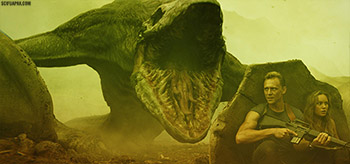 Photo courtesy of Warner Bros. Pictures. © 2017 WARNER BROS.ENTERTAINMENT INC., LEGENDARY PICTURES PRODUCTIONS, LLC AND PATPAC-DUNE ENTERTAINMENT LLC. ALL RIGHTS RESERVED
Photo courtesy of Warner Bros. Pictures. © 2017 WARNER BROS.ENTERTAINMENT INC., LEGENDARY PICTURES PRODUCTIONS, LLC AND PATPAC-DUNE ENTERTAINMENT LLC. ALL RIGHTS RESERVEDHumphries ensured the verisimilitude of the military jargon; consulted on airborne vehicles of the era, like the aforementioned UH-1 Huey helicopter, which was the primary means of air assault, delivery, transportation in Vietnam; and on the ordinance of a standard infantry unit, including the M-16 battle rifle and M-79 grenade launcher. Despite this massive firepower, Packard and his unit are in for the fight of their lives when taking on Kong and the other inhabitants of Skull Island. If Kong is the island’s king, then its other creatures are masters of their individual realms. Vogt-Roberts wanted each beast to stand out as something audiences have never seen. “When I was a child one of my favorite things was to experience something new at the movies,” he remarks. “I’d notice all of a monster’s idiosyncrasies.” Kong’s nemesis is the voracious Skullcrawler, an ancient beast that killed Kong’s ancestors, making him the last of his kind. “Skullcrawler is the fallen angel in Kong’s kingdom,” Vogt-Roberts asserts. “It lives underground and represents the bleaker aspects of the island and the darkness of the myth. It isn’t a perfectly constructed creature.” That may be an understatement: Skullcrawler resembles a serpent with two powerful arms and a terrifying skull-like face. For the animation team, the creature’s physiognomy was a challenge to choreograph, especially for a climactic fight scene. “Since the Skullcrawler has only two limbs and a very long tail, we had to find a way for it to be grounded and have a sense of balance,” says Scott Benza. “We have his tail support his weight in a way we don’t typically see in nature.” However difficult it was to maneuver, the Skullcrawler’s horrific visage and frame sparked the imaginations of the sound designers. “Jordan wanted it to be a thing that would sicken you and that just doesn’t belong in nature,” says Al Nelson. “It was impossible to go too far with the Skullcrawler’s vocalizations, and we really enjoyed making it sound as hideous as it looks.” An early reference was the sound of a dying rabbit—“that sort of pained squeal,” as Nelson describes it. He also played with the sounds of sea lions, “which make some of the most disgusting sounds heard in nature—like they’re trying to hack up a lung—as well as squirrels, which make this awful screeching sound when they’re calling out to each other; it’s really creepy. So when you think of this immense beast, you’re actually hearing a little squirrel,” he adds with a grin.
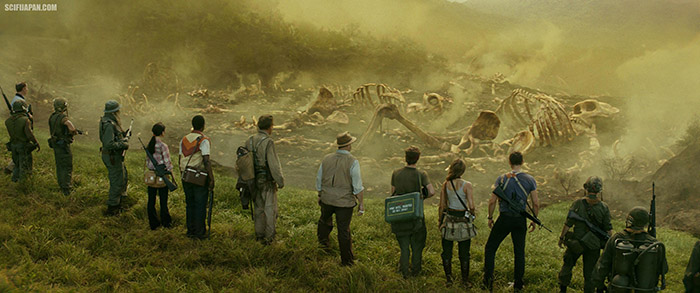 Photo courtesy of Warner Bros. Pictures. © 2017 WARNER BROS.ENTERTAINMENT INC., LEGENDARY PICTURES PRODUCTIONS, LLC AND PATPAC-DUNE ENTERTAINMENT LLC. ALL RIGHTS RESERVED
Photo courtesy of Warner Bros. Pictures. © 2017 WARNER BROS.ENTERTAINMENT INC., LEGENDARY PICTURES PRODUCTIONS, LLC AND PATPAC-DUNE ENTERTAINMENT LLC. ALL RIGHTS RESERVEDCLOSING NOTES Complementing the film’s sound design is a lush symphonic score composed by Henry Jackman. “The great thing about a monster movie is that it opens the door to use the symphony orchestra in its most sumptuous way,” he says. “Jordan was happy to celebrate the gravity and history that comes with a full orchestra, but we also explored less traditional elements. That’s a field day for a composer.” Jackman highlights Kong’s emotional connection with some of the characters by giving specific moments in the score what he says is “a bit of humanity and sensitivity.” Additionally, he cites the Wanderer scenes as being among his favorites. “John C. Reilly as Marlow is our guide through the shrine, so I composed what I call an ‘Americana element’—a patriotic theme connecting to Marlow and his background as a WWII fighter pilot.” In a nod to the period setting, Jackman infused the score with the bold, classic tones of ‘70s psychedelic guitars. These also facilitated seamless transitions to “needle drops” of some of the decade’s most memorable anthems. “I wanted to use songs from the Vietnam era and a myriad of hits from the ‘70s,” says Vogt-Roberts. “This provides a striking dichotomy, sets the tone and gives us great moments of fun. “We placed a record player on the boat the characters travel up the river in, with allows the music to be sourced from real places,” the director continues. “Their interaction with the music leads to some unexpected moments.” The songs heard on the soundtrack include: The Chambers Brothers’ “Time Has Come Today,” one of the landmark songs of the psychedelic era; the top-10 Jefferson Airplane hit “White Rabbit”; David Bowie’s “Ziggy Stardust”; The Hollies’ “Long Cool Woman (In A Black Dress)”; “Paranoid,” from Black Sabbath; Creedence Clearwater Revival’s “Bad Moon Rising” and “Run Through the Jungle”; “Down on the Street” from The Stooges; the Vietnamese psych rock hit “M?t Tr?i ?en”; and “Brother,” from Brazilian pop star Jorge Ben Jor. The music, which serves to both heighten the film’s emotion and underscore the action, was one of the final creative elements to fall into place during post-production. It was the culmination of a massive undertaking that had taken the production to three continents, where the filmmakers—led by Vogt-Roberts as well as producers Thomas Tull, Mary Parent, Jon Jashni and Alex Garcia—oversaw a shoot of uncommon complexity and great rewards. Throughout the process, everyone involved in the production was intent on being respectful of Kong’s history, even while crafting a next-generation iteration of the mythic beast. “The journey to make “Kong: Skull Island” has been an epic journey and an extraordinary experience for all of us,” Jordan Vogt-Roberts concludes. “We wanted to treat our Kong in a way that both honors what came before and blazes a new path.”
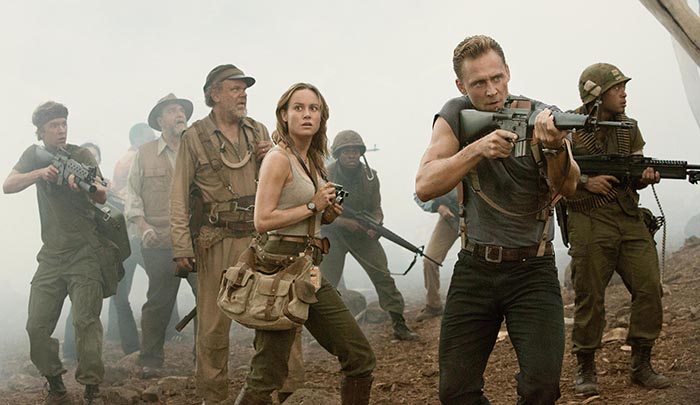 Photo courtesy of Warner Bros. Pictures. © 2017 WARNER BROS.ENTERTAINMENT INC., LEGENDARY PICTURES PRODUCTIONS, LLC AND PATPAC-DUNE ENTERTAINMENT LLC. ALL RIGHTS RESERVED
Photo courtesy of Warner Bros. Pictures. © 2017 WARNER BROS.ENTERTAINMENT INC., LEGENDARY PICTURES PRODUCTIONS, LLC AND PATPAC-DUNE ENTERTAINMENT LLC. ALL RIGHTS RESERVEDABOUT THE CAST
TOM HIDDLESTON (James Conrad) won a Golden Globe Award this year for Best Actor for his starring role as Jonathan Pine in the BBC’s acclaimed television adaption of John le Carre’s novel “The Night Manager.” He has received numerous accolades for the role, including Critics Choice and Emmy Best Actor nominations and a Favorite Drama Performance nomination at the National Television Awards.
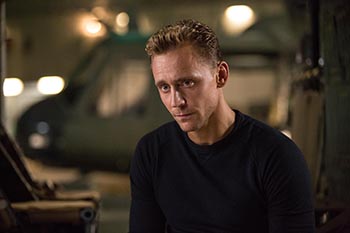 Photo courtesy of Warner Bros. Pictures. © 2017 WARNER BROS.ENTERTAINMENT INC., LEGENDARY PICTURES PRODUCTIONS, LLC AND PATPAC-DUNE ENTERTAINMENT LLC. ALL RIGHTS RESERVED
Photo courtesy of Warner Bros. Pictures. © 2017 WARNER BROS.ENTERTAINMENT INC., LEGENDARY PICTURES PRODUCTIONS, LLC AND PATPAC-DUNE ENTERTAINMENT LLC. ALL RIGHTS RESERVEDNext, Hiddleston returns to the role of the villain Loki, which he has portrayed in both the “Thor” and “Avenger” franchises since 2011, in “Thor: Ragnarok,” scheduled for released in November. He first played Loki in Kenneth Branagh’s “Thor,” for which he received Best Male Newcomer at the Empire Awards. He reprised the role in the 2012 blockbuster hit “The Avengers,” winning the MTV Movie Award for Best Villain for his role, as well as Best Fight, which he shared with Robert Downey Jr., Chris Evans, Mark Ruffalo, Chris Hemsworth, Scarlett Johansson and Jeremy Renner. Returning to the role in “Thor: The Dark World,” alongside an all-star cast including Hemsworth, Natalie Portman and Idris Elba, he received another Empire Award nomination, for Best Supporting Actor, in 2014, as well as another MTV Movie Award nomination, for Favorite Character. In 2015, Hiddleston starred in Guillermo del Toro’s “Crimson Peak,” alongside Jessica Chastain, Mia Wasikowska and Charlie Hunnam. That same year he also starred in Ben Wheatley’s thriller “High-Rise,” with an all-star cast including Jeremy Irons, Luke Evans, Sienna Miller and Elisabeth Moss, receiving a British Independent Film Award nomination for Best Actor for his role. He also starred in Marc Abraham’s “I Saw the Light,” the independent biopic about country music icon Hank Williams, based on the 1994 book Hank Williams: The Biography. The film premiered at the 2015 Toronto Film Festival. Prior to that, Hiddleston was seen in his breakthrough role in 2011 as Captain Nicholls in Steven Spielberg’s Oscar and Golden Globe nominated film “War Horse,” alongside Jeremy Irvine, Emily Watson, David Thewlis, Benedict Cumberbatch and Eddie Marsan. The same year he was memorable as F. Scott Fitzgerald in Woody Allen’s “Midnight in Paris,” for which he received acclaim. Among his other independent films are Jim Jarmusch’s “Only Lovers Left Alive,” starring alongside Tilda Swinton, John Hurt and Wasikowska; Joanna Hogg’s “Archipelago,” for which he was nominated for an Evening Standard British Film Award for Best Actor; and Terence Davies’ “The Deep Blue Sea,” opposite Rachel Weisz. His other accolades include a BAFTA Rising Star Award nomination in 2012. Up next, Hiddleston will lend his voice to the role of Lord Nooth in the animated film “Early Man,” alongside Eddie Redmayne. His prior television roles include Prince Hal in “Henry IV” Parts 1 & 2 and the title role in “Henry V,” which aired on the BBC as part of the highly anticipated Cultural Olympiad. He won the Times Breakthrough Award for this role at the 2013 South Bank Sky Arts Awards. On stage, Hiddleston was honored for his performance as “Coriolanus,” winning a London Evening Standard Theatre Award and earning an Olivier Award nomination, both for Best Actor. He starred in the play alongside Hadley Fraser and Mark Gatiss under the direction of the Donmar’s Artistic Director, Josie Rourke. In 2008, he received dual Olivier Award nominations in the category of Best Newcomer, for his work in “Cymbeline” and “Othello,” winning the award for the former. Hiddleston graduated from The Royal Academy of Dramatic Art in 2005.
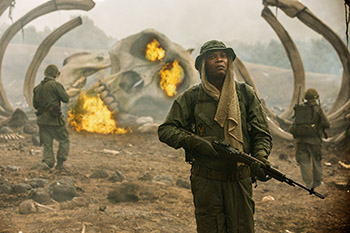 Photo courtesy of Warner Bros. Pictures. © 2017 WARNER BROS.ENTERTAINMENT INC., LEGENDARY PICTURES PRODUCTIONS, LLC AND PATPAC-DUNE ENTERTAINMENT LLC. ALL RIGHTS RESERVED
Photo courtesy of Warner Bros. Pictures. © 2017 WARNER BROS.ENTERTAINMENT INC., LEGENDARY PICTURES PRODUCTIONS, LLC AND PATPAC-DUNE ENTERTAINMENT LLC. ALL RIGHTS RESERVEDSAMUEL L. JACKSON (Preston Packard), one of the most respected actors in Hollywood, has appeared in well over 100 films. His portrayal of Jules, the philosopher hitman in Quentin Tarantino’s “Pulp Fiction,” made an indelible mark on American cinema. In addition to overwhelming critical acclaim, he garnered Academy Award and Golden Globe nominations and won a BAFTA Award, all in the category of Best Supporting Actor, and also won an Independent Spirit Award for Best Male Lead. Jackson has since reunited with Tarantino on a number of films, including “Jackie Brown,” for which he received another Golden Globe nod; “Kill Bill: Vol. 2”; “Django Unchained”; and, most recently, “The Hateful Eight.” Jackson has a nine-picture deal with Marvel Studios and has starred as action hero Nick Fury in three of their blockbuster franchises. Jackson has played the role in “Iron Man” and “Iron Man 2”; “Captain America: The First Avenger” and “Captain America: The Winter Soldier”; and “The Avengers,” which opened to a record-shattering $200+ million, and “Avengers: Age of Ultron.” He will also appear in the next installment of the “Avengers” franchise, “Avengers: Infinity War.” Jackson is also voicing the character of Jimbo in the animated action comedy “Blazing Samurai” and will lend his voice to “The Incredibles 2.” He has several films upcoming, including the action comedy “The Hitman’s Bodyguard”; Brie Larson’s feature directorial debut, “Unicorn Store”; and Peter Segal’s sci-fi film “Inversion.” His other recent films include the actioner “xXx: The Return of Xander Cage,” reprising the role of Agent Augustus Gibbons; Tim Burton’s fantasy adventure “Miss Peregrine’s Home for Peculiar Children”; David Yates’ “The Legend of Tarzan”; Matthew Vaughn’s hit “Kingsman: The Secret Service”; José Padilha’s remake of the classic sci-fi actioner “RoboCop”; and the Spike Lee-directed features “Chi-Raq” and “Oldboy,” a remake of the 2003 Korean cult classic. Jackson’s long list of credits also includes such diverse films as “Mother and Child,” receiving another Spirit Award nomination; “Lakeview Terrace”; “Soul Men”; “The Spirit”; “Jumper”; “Resurrecting the Champ”; “1408”; “Black Snake Moan”; “Snakes on a Plane”; “Freedomland”; “Coach Carter”; “Star Wars: Episode III – Revenge of the Sith”; “The Incredibles”; “S.W.A.T”; “Changing Lanes”; “Formula 51”; “Stars Wars: Episode II: Attack of the Clones”; “The Caveman’s Valentine”; “Unbreakable”; “Rules of Engagement”; “Shaft”; “Deep Blue Sea”; “Star Wars: Episode I: The Phantom Menace”; “The Negotiator”; “The Red Violin”; “Sphere”; “Eve’s Bayou”; “187”; “A Time to Kill,” gaining a Golden Globe nomination; “The Long Kiss Goodnight”; “Die Hard: With a Vengeance”; “True Romance”; “Jurassic Park”; “Patriot Games”; “Jungle Fever”; “Goodfellas”; “Mo’ Better Blues”; “Sea of Love”; “Do the Right Thing”; “Coming to America”; “School Daze”; and “Ragtime.” In 2011, Jackson made his Broadway debut in “The Mountaintop,” at the Bernard B. Jacobs Theater, where he portrayed Martin Luther King Jr. The play also starred Angela Bassett and was directed by Kenny Leon. Jackson began his career onstage upon his graduation from Morehouse College in Atlanta with a degree in Dramatic Arts. Among his early plays were “Home,” “A Soldier’s Play,” “Sally/Prince” and “The District Line.” He also originated roles in two of August Wilson’s plays at Yale Repertory Theatre. For the New York Shakespeare Festival, Jackson appeared in “Mother Courage and Her Children,” “Spell #7” and “The Mighty Gents.” On the small screen, Jackson starred in the 2011 HBO movie “The Sunset Limited.” He earlier starred in John Frankenheimer’s Emmy-winning “Against the Wall,” also for HBO. His performance brought him Cable ACE and Golden Globe nominations for Best Supporting Actor in a Movie or Miniseries. In addition, he served as executive producer for the Spike TV animated series “Afro Samurai,” which premiered in 2007 and ran for three seasons. The series received an Emmy Award nomination for Outstanding Animated Program. The first edition of the “Afro Samurai” video game launched in February 2009.
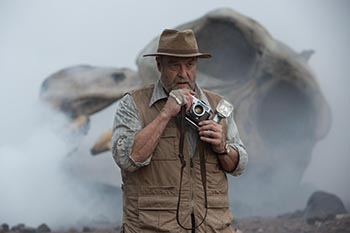 Photo courtesy of Warner Bros. Pictures. © 2017 WARNER BROS.ENTERTAINMENT INC., LEGENDARY PICTURES PRODUCTIONS, LLC AND PATPAC-DUNE ENTERTAINMENT LLC. ALL RIGHTS RESERVED
Photo courtesy of Warner Bros. Pictures. © 2017 WARNER BROS.ENTERTAINMENT INC., LEGENDARY PICTURES PRODUCTIONS, LLC AND PATPAC-DUNE ENTERTAINMENT LLC. ALL RIGHTS RESERVEDJOHN GOODMAN (Bill Randa) recently made his West End debut starring alongside Damian Lewis and Tom Sturridge in the revival of David Mamet’s 1975 play “American Buffalo” at the Wyndham’s Theatre in London. Last winter, Goodman returned to the stage in the Broadway revival of Ben Hecht and Charles MacArthur’s “The Front Page,” starring alongside Nathan Lane and John Slattery. His upcoming films include David Leicht’s thriller “The Coldest City,” and lending his voice to Luc Besson’s sci-fi adventure “Valerian and the City of a Thousand Planets.” His recent films include “Patriots Day”; the hit sci-fi thriller “10 Cloverfield Lane,” for which he received numerous critics’ nods; and Jay Roach’s biographical drama “Trumbo.” In 2013, Goodman starred in Ben Affleck’s drama “Argo,” which won the Academy Award for Best Picture, and in Robert Zemeckis’ thriller “Flight.” That same year, he won the 2013 National Board of Review Spotlight Award for his work in “Argo,” “Flight” and “Trouble with the Curve.” Goodman was also seen in the black-and-white silent feature “The Artist,” which won the 2012 Academy Award for Best Picture. His other TV credits include Amazon’s original series “Alpha House,” the Starz miniseries “Dancing on the Edge,” DirecTV’s “Damages,” and NBC’s “Community.” Among Goodman’s many accolades are a Golden Globe Award for Best Actor and seven Emmy nominations for his role in “Roseanne.” He also won Emmy nominations for his starring roles in TNT’s “Kingfish: A Story of Huey P. Long,” in the CBS production of Tennessee Williams’ “A Streetcar Named Desire” and in the Coen Brothers film “Barton Fink.” In 2007, Goodman won his second Emmy, for Outstanding Guest Actor, on “Studio 60 on the Sunset Strip.” HBO’s biopic of Jack Kevorkian, “You Don’t Know Jack,” reunited Goodman with Al Pacino and Susan Sarandon. He won an Emmy nomination for Outstanding Supporting Actor in a Miniseries or a Movie and a SAG nomination for Outstanding Performance by a Male Actor in a Television Movie or Miniseries. His previous film credits include “Transformers: Age of Extinction,” the remake of 1974’s “The Gambler,” “Monument’s Men,” “Inside Llewyn Davis,” “Monster’s University,” “Extremely Loud & Incredibly Close,” “In The Electric Mist,” “Confessions of a Shopaholic,” “Speed Racer,” “Bee Movie,” “Pope Joan,” “Alabama Moon,” “Gigantic,” “Marilyn Hotchkiss’ Ballroom Dancing and Charm School,” “Beyond the Sea,” “Masked and Anonymous,” “Storytelling,” “O Brother, Where Art Thou?,” “Coyote Ugly,” “What Planet Are You From?,” “One Night at McCool’s,” “Bringing Out the Dead,” “Fallen,” “The Borrowers,” “Blues Brothers 2000,” “The Runner,” “The Flintstones,” “Mother Night,” “Arachnophobia,” “Always,” “Pie in the Sky,” “Born Yesterday,” “Matinee,” “The Babe,” “King Ralph,” “Punchline,” “Everybody`s All-American,” “Sea of Love,” “Stella,” “Eddie Macon`s Run,” “C.H.U.D.,” “Revenge of the Nerds,” “Maria`s Lovers,” “Sweet Dreams,” “True Stories,” “The Big Easy,” “Burglar,” “The Wrong Guys,” “Raising Arizona” and “The Big Lebowski.” He has lent his voice to many animated films, including “Monsters, Inc.,” “The Emperor’s New Groove,” “Tales of the Rat Fink” and “The Jungle Book II.” He also voiced a main character in NBC’s animated series “Father of the Pride.” A St. Louis native, Goodman, went to Southwest Missouri State intending to play football, but an injury led him to switch his major to drama. He never returned to football and graduated with a degree in Theatre. Goodman starred on Broadway in “Waiting for Godot,” for which he received rave reviews as Pozzo. His other stage credits include many dinner theatre and children`s theatre productions, as well as several off-Broadway plays. His regional theatre credits include “Henry IV, Parts I and II,” “Antony and Cleopatra,” “As You Like It” and “A Christmas Carol.” He performed in a road production of “The Robber Bridegroom” and starred in two Broadway shows, “Loose Ends” in 1979 and “Big River” in 1985. In 2001, he starred in the NY Shakespeare Festival Central Park staging of “The Seagull,” directed by Mike Nichols. The following year he appeared on Broadway in the Public Theatre’s “Resistible Rise of Arturo Ui.”
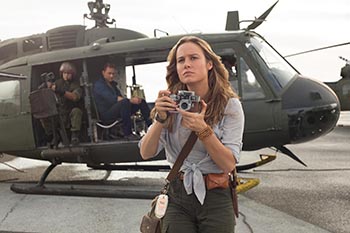 Photo courtesy of Warner Bros. Pictures. © 2017 WARNER BROS.ENTERTAINMENT INC., LEGENDARY PICTURES PRODUCTIONS, LLC AND PATPAC-DUNE ENTERTAINMENT LLC. ALL RIGHTS RESERVED
Photo courtesy of Warner Bros. Pictures. © 2017 WARNER BROS.ENTERTAINMENT INC., LEGENDARY PICTURES PRODUCTIONS, LLC AND PATPAC-DUNE ENTERTAINMENT LLC. ALL RIGHTS RESERVEDBRIE LARSON (Mason Weaver) won Oscar, Golden Globe, Screen Actors Guild, BAFTA, Critics’ Choice, National Board of Review, and Independent Spirit Awards last year, in the category of Best Actress, for her breakthrough performance as Ma in Lenny Abrahamson’s “Room.” The film was adapted from the best-selling book about a young woman and her five-year-old son who finally gain their freedom after being held captive for years in an enclosed space. She will next be seen in the Martin Scorsese executive produced ‘70s crime thriller “Free Fire,” directed by Ben Wheatley, which premiered at the 2016 Toronto and London Film Festivals and will be released in theatres in April; “The Glass Castle,” based on the best-selling memoir by Jeannette Walls, reteaming her with director Destin Daniel Cretton; “Unicorn Store,” marking her feature directorial debut, in which she also stars; and Marvel’s first female-led superhero film, “Captain Marvel.” In 2014, Larson starred in “Short Term 12,” her first collaboration with Cretton. Her dramatic role as Grace, the director of a foster care facility, earned her Best Actress wins at the Locarno Film Festival and Gotham Awards, and a Best Actress nomination at the Critics’ Choice Awards. The Los Angeles Times labeled her the It Girl of the SXSW film festival, where the film first premiered. Larson has worked with esteemed directors and co-stars on numerous films, including Judd Apatow’s “Trainwreck,” opposite writer/star Amy Schumer; Rupert Wyatt’s “The Gambler,” opposite Mark Wahlberg; James Ponsoldt’s “The Spectacular Now,” opposite Shailene Woodley and Miles Teller; Joseph Gordon-Levitt’s directorial debut, “Don Jon”; Phil Lord and Chris Miller’s “21 Jump Street,” as the love interest to Jonah Hill; Oren Moverman’s “Rampart,” as the defiant daughter of Woody Harrelson’s character; Edgar Wright’s “Scott Pilgrim vs. the World”; and Noah Baumbach’s “Greenberg,” as a young temptress flirting with Ben Stiller. Larson is still widely recognized for her portrayal of Toni Collette’s sarcastic and rebellious daughter in Showtime’s breakout drama “United States of Tara,” created by Academy Award-winning writer Diablo Cody and based on an original idea by Steven Spielberg. She also had a recurring role on the F/X cult favorite series “The League.” She has appeared on stage at the prestigious Williamstown Theater Festival in the role of Emily in “Our Town.” In addition to acting and directing, Larson is a writer. Her short film “The Arm” won the Special Jury Award for Best Comedic Storytelling at the 2012 Sundance Film Festival. A native of Sacramento, Larson started studying drama at the early age of six, as the youngest student ever to attend the American Conservatory Theater in San Francisco.
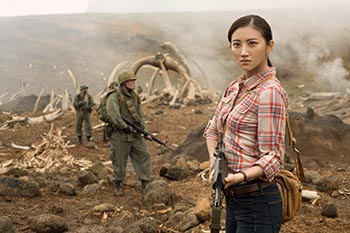 Photo courtesy of Warner Bros. Pictures. © 2017 WARNER BROS.ENTERTAINMENT INC., LEGENDARY PICTURES PRODUCTIONS, LLC AND PATPAC-DUNE ENTERTAINMENT LLC. ALL RIGHTS RESERVED
Photo courtesy of Warner Bros. Pictures. © 2017 WARNER BROS.ENTERTAINMENT INC., LEGENDARY PICTURES PRODUCTIONS, LLC AND PATPAC-DUNE ENTERTAINMENT LLC. ALL RIGHTS RESERVEDJING TIAN (San) has emerged as one of the most exciting young actresses in the international film community and is poised to make her mark in the US. In February, Tian will make her American film debut in “The Great Wall.” In the film, Tian plays the role of Chinese General Lin Mei, opposite Matt Damon. In February 2018, Tian will star with John Boyega and Scott Eastwood in “Pacific Rim: Uprising.” Over the past two years, Tian has become one of China’s leading actresses in both film and television. Holding her own with Chinese film legends, she has built a reputation as one of the most dynamic women in the industry. Often using her extensive physical dance training as an asset, Tian has taken on every role with intense training, as she often prefers to perform her own stunts. From 2013 to 2014, Tian stared in three blockbuster films: “Special ID,” with Donnie Yen; “Police Story 2013,” with the legendary Jackie Chan; and “From Vegas to Macao,” with another Chinese legend, Chow Yun-Dat. These three films had box office revenues of more than 1.3 Billion RMB. Her strong performances in those films led her to the 18th Annual Hollywood Film Awards, where Tian won the inaugural Hollywood International Award. Complementing her big screen success, Tian has also portrayed widely beloved characters on Chinese television. In early 2014, she starred in Yu Zheng’s ”Ban Shu Legend” (Banshu chuanqi), an historical drama set in the Han dynasty. Tian portrayed the title character, Ban Shu, a beautiful young teacher at the Imperial Palace kindergarten who captures the attention and heart of the Emperor. Her latest television drama, “The Glory of Tang Dynasty,” which premiered during the Chinese New Year and airs in China until May, has been a huge success with over 1.3 billion views on Tencent, China’s largest online platform. Tian attracted widespread attention with her 2010 movie debut, “My Belle Boss” (Wo de meinu laoban), in which the then-22-year-old actress played two conflicting roles. Over the next two years, she took on challenging roles in a series of large historical costume dramas such as “The Warring States” (Zhan Guo), “Better and Better” (Yue Lai Yue Hao) and “Tears in Heaven.” Tian grew up in Xi’an, Shanxi province, a city with 7,000 years of history where the vast armies of Terracotta Warriors were discovered dating from the Qin dynasty and the first Emperor of China. She left home at age 13 to begin extensive training at the Secondary School of the Beijing Dance Academy. Her love of dancing soon flourished into a passion for acting and upon graduation, she went on to complete her education at the Beijing Film Academy. Off screen, Tian’s success is equally matched as one of the faces of L’Oreal in Asia. She also devotes a great deal of her time towards humanitarian efforts supporting missions to earthquake stricken areas, as well as aiding disadvantaged children.
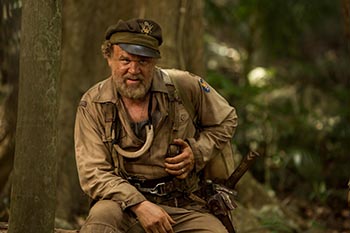 Photo courtesy of Warner Bros. Pictures. © 2017 WARNER BROS.ENTERTAINMENT INC., LEGENDARY PICTURES PRODUCTIONS, LLC AND PATPAC-DUNE ENTERTAINMENT LLC. ALL RIGHTS RESERVED
Photo courtesy of Warner Bros. Pictures. © 2017 WARNER BROS.ENTERTAINMENT INC., LEGENDARY PICTURES PRODUCTIONS, LLC AND PATPAC-DUNE ENTERTAINMENT LLC. ALL RIGHTS RESERVEDJOHN C. REILLY (Hank Marlow) is a versatile actor who has appeared in a wide variety of film and television projects, as well as on the stage. He has worked with numerous directors on an array of films, including: Martin Scorsese’s “Gangs of New York” and “The Aviator”; Brian DePalma’s “Casualties of War”; Robert Altman’s “A Prairie Home Companion”; Terrence Malick’s “The Thin Red Line”; Roman Polanski’s “Carnage”; Wolfgang Petersen’s “The Perfect Storm”; Lynne Ramsay’s “We Need to Talk About Kevin”; and Paul Thomas Anderson’s “Hard Eight,” “Boogie Nights” and “Magnolia.” Reilly also starred in Adam McKay’s hit comedies “Talladega Nights: The Ballad of Ricky Bobby” and “Stepbrothers,” both opposite Will Ferrell; and in the indie film “Cyrus,” directed by the Duplass brothers. His additional work in the world of independent film includes “The Good Girl,” “Cedar Rapids,” “The Promotion,” “Terri,” “Year of the Dog,” “Criminal,” “The Anniversary Party,” “Life After Beth” and, most recently, “The Little Hours,” which premiered at this year’s Sundance Film Festival. He was also in Yorgos Lanthimos’ “The Lobster,” Thomas Bidegain’s “Les Cowboys” and Matteo Garrone’s “The Tale of Tales” which were all selections at the 2015 Cannes Film Festival. For his role in the musical “Chicago” he was nominated for an Oscar for Best Supporting Actor as well as a Golden Globe Award in the same category. He received another Golden Globe nomination, for Best Actor in a Comedy or Musical, for “Walk Hard: The Dewey Cox Story.” His work has also garnered multiple Independent Spirit Award and Screen Actors Guild Award nominations, as well as critics’ nods. Among his other films are James Gunn’s blockbuster sci-fi adventure “Guardians of the Galaxy,” and lending his voice to the title character in the Oscar-nominated animated feature “Wreck-It Ralph” as well as to Eddie in “Sing.” He is currently filming “Holmes and Watson,” in which he stars in the role of Watson, opposite Will Ferrell’s Holmes, for director Etan Cohen. On television, Reilly is a frequent collaborator with comedians Tim Heidecker and Eric Wareheim for the shows “Tim and Eric’s Awesome Show, Great Job” and “Check It Out, with Dr. Steve Brule,” among others. His many theater credits include “True West,” for which he received a Tony Award nomination, and “A Streetcar Named Desire” on Broadway, as well as Steppenwolf productions of “The Grapes of Wrath” and “A Streetcar Named Desire” in Chicago.
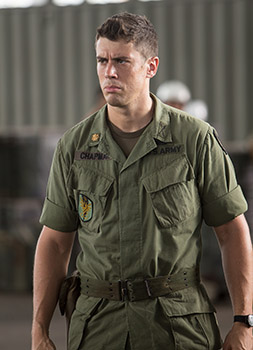 Photo courtesy of Warner Bros. Pictures. © 2017 WARNER BROS.ENTERTAINMENT INC., LEGENDARY PICTURES PRODUCTIONS, LLC AND PATPAC-DUNE ENTERTAINMENT LLC. ALL RIGHTS RESERVED
Photo courtesy of Warner Bros. Pictures. © 2017 WARNER BROS.ENTERTAINMENT INC., LEGENDARY PICTURES PRODUCTIONS, LLC AND PATPAC-DUNE ENTERTAINMENT LLC. ALL RIGHTS RESERVEDTOBY KEBBELL (Jack Chapman / Kong Mo Cap Services) is a UK native who has starred in several action-packed fantasy adventures, among these his memorable performance-capture portrayals as the warmongering chimpanzee Koba in Matt Reeves’ “Dawn of the Planet of the Apes” and as the heroic Durotan in Duncan Jones’ “Warcraft: The Beginning.” He starred as the villainous Messala in “Ben-Hur,” directed by Timur Bekmambetov and released in the summer of 2016. In 2016, he was also seen in the role of Jennings in Stephen Gaghan’s thriller “Gold,” and as Dad in the fantasy “A Monster Calls.” Kebbell first caught the attention of the British public with his 2004 feature film debut, when director Shane Meadows cast him in the role of Anthony in “Dead Man’s Shoes.” His portrayal of a young man with a learning disability earned him a nomination for Most Promising Newcomer at the British Independent Film Awards (BIFA). His next features were Oliver Stone’s “Alexander” and Woody Allen’s “Match Point.” Critical acclaim came his way anew in 2007 when he played Rob Gretton, the manager of Joy Division, in Anton Corbijn’s award-winning “Control.” Kebbell won the BIFA Award for Best Supporting Actor and was nominated for the London Critics’ Circle Film Award. His standout performance in Guy Ritchie’s “RocknRolla” earned him The Sun newspaper’s Best Actor award as well as an Empire Award nomination. Kebbell was also nominated for BAFTA’s Rising Star Award in 2009. His other films include Steven Spielberg’s “War Horse,” Mike Newell’s “Prince of Persia: The Sands of Time,” Jon Turtletaub’s “The Sorcerer’s Apprentice,” Jonathan Liebesman’s “Wrath of the Titans,” Ridley Scott’s “The Counselor” and Robert Redford’s “The Conspirator.” On television, Kebbell took the lead in an episode of Jimmy McGovern’s BBC series “The Street,” which subsequently won the BAFTA Award for Best Drama. His other work for the BBC includes a modern retelling of “Macbeth,” alongside James McAvoy. For Channel 4, he starred in an episode of “Black Mirror.” On stage, he has performed at the Almeida Theatre, in Sir David Hare’s reworking of “Maxim Gorky’s Enemies” and at the Playhouse Theatre in R.C. Sherriff’s classic “Journey’s End.” JOHN ORTIZ (Victor Nieves) is an award-winning actor who honed his craft on the New York stage. He won the Obie Award for Best Actor in the Off-Broadway production of “References to Salvador Dali Make Me Hot,” and was nominated for an Independent Spirit Award for his performance in the indie film “Jack Goes Boating.” He is equally at home on stage, in feature films, and on television. Ortiz will next be seen in Zach Braff’s comedy “Going in Style,” starring Morgan Freeman, Michael Caine and Alan Arkin, in theatres this April. Ortiz recently wrapped “God Particle,” produced by J.J. Abrams, starring Chris O’Dowd and Elizabeth Debicki; “Nostalgia,” starring Jon Hamm and Nick Offerman; and “Replicas” with Keanu Reeves and Alice Eve. He also starred in “A Dog’s Purpose”; “A Woman, A Part,” opposite Maggie Siff and Cara Seymour; “Steve Jobs,” starring Michael Fassbender and Kate Winslet; “Blackhat,” starring Chris Hemsworth; “The Drop,” starring Tom Hardy and James Gandolfini; and Diego Luna’s “Cesar Chavez,” opposite Michael Pena. Among his other credits are the Oscar nominated film “Silver Linings Playbook”; “Jack Goes Boating,” in which he not only starred but also produced with Phillip Seymour Hoffman; “Public Enemies,” “Fast & Furious 6,” “Pride and Glory,” “American Gangster,” “Alien vs. Predator: AVP2,” “Miami Vice,” “El Cantante,” “Amistad,” “Carlito’s Way,” “Narc,” “Ransom,” “Riot,” “Side Streets,” “Sgt. Bilko,” “Before Night Falls,” “The Opportunists,” and “The Last Marshall.” On television, Ortiz starred opposite Greg Kinnear in Fox’s “Rake.” He can be seen in the TBS comedy “The Guest Book,” starring Kellie Martin and the HBO series “Togetherness,” starring Amanda Peet and Melanie Lynskey. He also starred opposite Dustin Hoffman in the cable series “Luck,” and was a series regular on “Clubhouse,” “The Job,” and “Lush Life.” Along with Hoffman, Ortiz is the co-founder of LAByrinth Theater Company, where he has produced and performed in many productions, including “The Last Days of Judas Iscariot,” directed by Hoffman; “Jesus Hopped The ‘A’ Train,” for which he was awarded a Drama Desk nomination; “Guinea Pig Solo;” and “Jack Goes Boating;” all of which were staged at the Public Theater in New York. Most recently, he starred in the title role of “Othello,” opposite Hoffman. The production, directed by Peter Sellars, premiered in Vienna and toured internationally. His other New York theater credits include the Broadway production of “Anna in the Tropics”; “The Skin of our Teeth,” with John Goodman at the Public Theater; and “Cloud Tectonics” at Playwrights Horizon. Additionally, Ortiz was in “The Persians” and “Merchant of Venice,” both directed by Peter Sellars and performed in Paris, London, Berlin and Edinburgh, among other cities. Regionally, Ortiz has performed at the Mark Taper Forum, the Goodman Theatre, Hartford Stage, Arena Stage, Yale Repertory Theatre, South Coast Repertory and Cincinnati Playhouse. A devoted fan of the New York Yankees and the New York Knicks, Ortiz was born and raised in Brooklyn.
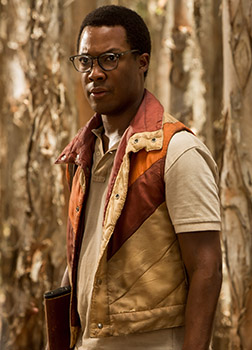 Photo courtesy of Warner Bros. Pictures. © 2017 WARNER BROS.ENTERTAINMENT INC., LEGENDARY PICTURES PRODUCTIONS, LLC AND PATPAC-DUNE ENTERTAINMENT LLC. ALL RIGHTS RESERVED
Photo courtesy of Warner Bros. Pictures. © 2017 WARNER BROS.ENTERTAINMENT INC., LEGENDARY PICTURES PRODUCTIONS, LLC AND PATPAC-DUNE ENTERTAINMENT LLC. ALL RIGHTS RESERVEDCOREY HAWKINS (Houston Brooks) gained recognition with his breakout performance as iconic music producer and hip hop legend Dr. Dre in F. Gary Gray’s N.W.A. biopic, “Straight Outta Compton.” The film spent three consecutive weeks in the #1 spot at the box office and is the highest-grossing music biopic in history, earning more than $201 million worldwide. Hawkins can currently be seen starring on the small screen as Eric Carter in FOX’s “24” reboot, “24: Legacy,” opposite Miranda Otto and Jimmy Smits. Hawkins takes the place of the original Jack Bauer role portrayed by Kiefer Sutherland. The series made its mid-season debut after the 2017 Super Bowl before moving to its regular Monday-night time slot. In 2015, Hawkins joined the cast of the hit AMC show “The Walking Dead” as Heath, a major character from the comic series. He made appearances in the sixth and seventh season in the role. Hawkins’ additional film credits include “Non-Stop” and “Iron Man 3.” On stage, Hawkins starred on Broadway as Tybalt in David Leveaux’s 2013 revival of Shakespeare’s “Romeo and Juliet,” opposite Orlando Bloom and Condola Rashad. In April 2017, he will return to Broadway in the highly anticipated revival of John Guare’s renowned drama “Six Degrees of Separation. Hawkins will star opposite Allison Janney and John Benjamin Hickey over the play’s two-month run. Hawkins is a graduate of The Juilliard School’s drama program and is a recipient of the prestigious John Houseman Prize, given to one Juilliard student who has demonstrated exceptional ability in classical theater.
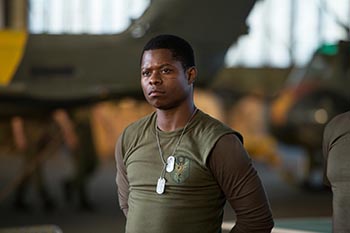 Photo courtesy of Warner Bros. Pictures. © 2017 WARNER BROS.ENTERTAINMENT INC., LEGENDARY PICTURES PRODUCTIONS, LLC AND PATPAC-DUNE ENTERTAINMENT LLC. ALL RIGHTS RESERVED
Photo courtesy of Warner Bros. Pictures. © 2017 WARNER BROS.ENTERTAINMENT INC., LEGENDARY PICTURES PRODUCTIONS, LLC AND PATPAC-DUNE ENTERTAINMENT LLC. ALL RIGHTS RESERVEDJASON MITCHELL (Mills) has steadily been building a reputation as an actor on the rise. He achieved critical acclaim for his portrayal of the iconic Eazy E in the 2015 N.W.A. biopic “Straight Outta Compton,” starring opposite Paul Giamatti under the direction of F Gary Gray. He beat out competition from around the country for this coveted role. Mitchell won the African American Film Critics Association Award for Best Supporting Actor for his performance, in addition to sharing Best Motion Picture Ensemble Award nominations with his fellow castmates at both the Screen Actors Guild Awards and the Critics’ Choice Awards. He also received Variety and San Diego International Film Festival’s Rising Star Award in 2016 for his work in the film. He was recently seen in Vikram Gandhi’s “Barry,” for Netflix, the story of Obama’s college days in New York City, and Dee Rees’ “Mudbound,” shot in New Orleans, which received critical acclaim at the 2017 Sundance Film Festival. Mitchell will next be seen in Kathryn Bigelow’s currently untitled Detroit Riots Project, as well as “The Chi” for Showtime, a timely and distinctive coming-of-age story that follows a half dozen interrelated characters in the South Side of Chicago. SHEA WHIGHAM (Cole) was born in Florida and educated at SUNY Purchase. Armed with a New York City theatre background, Whigham got his big break in 2000 when director Joel Schumacher cast him opposite Colin Farrell in “Tigerland.” Since then he has amassed an impressive list of credits, working with such legendary film directors as Martin Scorsese, Robert Redford, Terrence Malick, Werner Herzog, Oliver Stone, David O. Russell and Robert Rodriguez, as well as next generation auteurs such as David Gordon Green, Jeff Nichols, James Ponsoldt and Adam Wingard. The litany of formidable and world class actors he has worked alongside is equally long: Robert De Niro, Anthony Hopkins, Leonardo DiCaprio, Christian Bale, Sean Penn and Viola Davis, to name a few. Whigham also joined the “Star Trek” universe in the recent film installment “Star Trek Beyond.” His work as Eli Thompson on HBO’s smash hit “Boardwalk Empire,” alongside Steve Buscemi and Kelly MacDonald, helped to earn him and the show numerous Screen Actors Guild (SAG) Awards for Best Ensemble. His additional television credits include Cary Fukunaga’s “True Detective” for HBO, ABC’s “Agent Carter,” and Graham Yost’s F/X drama “Justified.” Most recently, he was seen on HBO’s comedy series “Vice Principals,” opposite Danny McBride. Whigham’s recent film releases include the indie films “Cop Car,” opposite Kevin Bacon, and “Lila & Eve,” with Jennifer Lopez and Viola Davis, which both premiered at the 2015 Sundance Film Festival; Malick’s “Knight of Cups”; and “A Country Called Home,” alongside Mackenzie Davis and Imogen Poots. Whigham’s upcoming slate is just as prolific: “High Wire Act,” opposite Jon Hamm; Netflix’s motion picture remake of the Japanese Manga series “Death Note”; the highly anticipated “Sicario” sequel, “Soldado”; “Wheelman,” opposite Frank Grillo for Netflix; an appearance on the hit show “Narcos”; and the Amazon TV series “Legend of Master Legend,” based on the Rolling Stone article. THOMAS MANN (Slivko) is currently in production on Nicole Holofcenter’s New York-based drama “The Land of Steady Habits,” in which he appears opposite Ben Mendelsohn and Edie Falco. Mann had a busy 2016, appearing onstage opposite Jason Sudeikis in the Classic Stage Company’s off-Broadway production of “Dead Poets Society,” in addition to appearing in the independent features “The Stanford Prison Experiment” and “The Preppie Connection.” He also completed production on the Blumhouse Productions horror film “Amityville: The Awakening,” which is set for release in 2017. In 2015, Mann starred in Alfonso Gomez-Rejon’s critically acclaimed feature “Me, Earl and the Dying Girl,” which won both the audience and jury prizes at the Sundance Film Festival that year, before being released in theatres. The movie adapted from Jesse Andrews’ debut novel, also starred Olivia Cooke, Nick Offerman, Jon Bernthal and Connie Britton. Following his breakout turn in the comedy “Project X,” Mann went on to star in major studio movies including “Hansel and Gretel: Witch Hunter,” alongside Jeremy Renner and Gemma Arterton; “Beautiful Creatures,” alongside Alden Ehrenreich, Jeremy Irons, Viola Davis and Emma Thompson; and “Fun Size,” opposite Victoria Justice. His previous credits also include the independent features “It’s Kind of a Funny Story,” “As Cool as I Am,” “Welcome to Me” and “Brain on Fire.” EUGENE CORDERO (Reles) was most recently seen in “Ghostbusters” and “Mike and Dave Need Wedding Dates.” He previously starred alongside Alison Brie and Nick Offerman in Jordan Vogt-Roberts feature film directorial debut, “The Kings of Summer,” which premiered at the 2013 Sundance Film Festival and screened at a number of other film festivals before being released in theatres. His recent TV credits include “The Good Place,” “Crazy Ex-Girlfriend,” “Parks and Recreation,” “Key and Peele,” “Drunk History” and “House of Lies.” Cordero also booked a series regular role opposite Craig Ferguson on NBC’s hybrid game show/comedy pilot “Crunch Time.” He was also a series regular on Paul Feig’s Yahoo series “Other Space.” In addition, Cordero is a veteran performer at The Upright Citizens Brigade (UCB). TERRY NOTARY (Kong Mo Cap Services) is an actor, director, creature performer, animal movement specialist, choreographer and stunt coordinator who has worked with the industry’s leading directors, including Steven Spielberg, James Cameron, Peter Jackson and Ron Howard. Notary has served as movement choreographer and performed in a slate of films on the cutting edge of performance capture. Upcoming he again portrays alpha chimp Rocket in “War for the Planet of the Apes.” Notary previously portrayed Rocket in both “Rise of the Planet of the Apes” and “Dawn of the Planet of the Apes. “ He also served as movement choreographer and stunt coordinator on the films, as well as on 2001’s “Planet of the Apes.” His work will also next be seen in Andy Serkis’ “Jungle Book: Origins.” In addition to choreographing, Notary also served as the film’s second unit director. Previous films in which he served as movement choreographer and mo cap performer include “Warcraft: The Beginning,” “The Adventures of Tintin,” “The Incredible Hulk,” and “The Fantastic 4: Rise of the Silver Surfer.” His other films as movement choreographer include “Suicide Squad,” “The BFG,” “Fantastic Four,” “The Hobbit” Trilogy, “Transformers: Revenge of the Fallen,” “Superman Returns” and “How the Grinch Stole Christmas.” While at university, Notary was a four-time NCAA All American and captain of the UCLA gymnastics team. Upon graduating with a BA in theater, he was recruited by the Cirque du Soleil, where he and 15 other performers from around the world formed Cirque’s prestigious troup maison and created the show “Mystere.” For five years, Notary performed in the acclaimed production as a lead acrobat and character performer, as well as lead acrobat on the teeter board, Chinese poles and trampoline as well as musician on the taiko drums. When not working in film, he teaches master class movement workshops around the world. Plans are underway for Notary to direct his first feature.
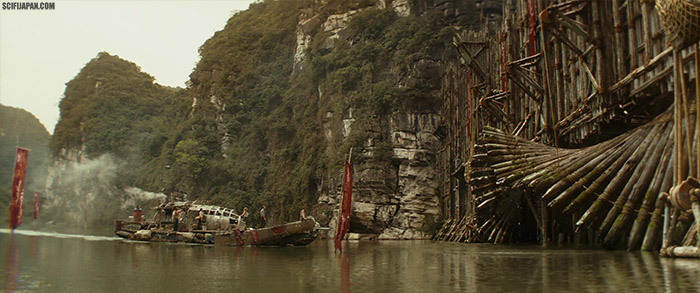 Photo courtesy of Warner Bros. Pictures. © 2017 WARNER BROS.ENTERTAINMENT INC., LEGENDARY PICTURES PRODUCTIONS, LLC AND PATPAC-DUNE ENTERTAINMENT LLC. ALL RIGHTS RESERVED
Photo courtesy of Warner Bros. Pictures. © 2017 WARNER BROS.ENTERTAINMENT INC., LEGENDARY PICTURES PRODUCTIONS, LLC AND PATPAC-DUNE ENTERTAINMENT LLC. ALL RIGHTS RESERVEDABOUT THE FILMMAKERS
JORDAN VOGT-ROBERTS (Director) is an American film and television director hailing from the ashes of Detroit. Vogt-Roberts began his feature career with the film, “The Kings of Summer,” which he directed. The film premiered in competition at the 2013 Sundance Film Festival to critical acclaim.
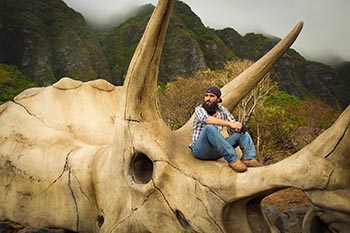 Photo courtesy of Warner Bros. Pictures. © 2017 WARNER BROS.ENTERTAINMENT INC., LEGENDARY PICTURES PRODUCTIONS, LLC AND PATPAC-DUNE ENTERTAINMENT LLC. ALL RIGHTS RESERVED
Photo courtesy of Warner Bros. Pictures. © 2017 WARNER BROS.ENTERTAINMENT INC., LEGENDARY PICTURES PRODUCTIONS, LLC AND PATPAC-DUNE ENTERTAINMENT LLC. ALL RIGHTS RESERVEDThe very next year in 2014, Vogt-Roberts was back at Sundance as a producer and director for the world premiere of Nick Offerman’s Netflix concert film “Nick Offerman: American Ham.” Prior to the success of “The Kings of Summer,” Vogt-Roberts directed the short film “Successful Alcoholics,” starring Lizzy Caplan, Nick Kroll and Tony Hale. The film debuted at the 2010 Sundance Film Festival and subsequently screened at more than 30 festivals worldwide, including South by Southwest and AFI. On the television and web side, Vogt-Roberts created and directed the incredibly visual-minded Comedy Central television series “Mash Up” in 2011. He also directed Stephen Falk’s pilot “You’re the Worst,” which is now a hit original series on FX Networks entering its fourth season. Vogt-Roberts also creates web and commercial content for Ridley Scott’s RSA productions where he has also directed award-winning projects that have reached millions of viewers. This includes a recent campaign for Audi starring Claire Danes and a PSA with Arnold Schwarzenegger crushing cars in his M47 Patton tank, which got over 10 million views in one day and raised over $1 million for charity. Vogt-Roberts’ early work in web content with comedians like Thomas Middleditch, Kumail Nanjiani, Hannibal Buress and Pete Holmes helped lay the groundwork for current online content creation and distribution models. He is currently attached to direct the video game adaption “Metal Gear Solid” and uses his free time to help with a non-profit called the Detroit Creativity Project that offers improv free of charge in Detroit public schools. DAN GILROY (Screenplay) made his feature directorial debut with the 2014 film “Nightcrawler,” starring Jake Gyllenhaal and Gilroy’s wife, Rene Russo, He also wrote the script and received an Academy Award nomination for Best Original Screenplay. Gilroy is currently in pre-production on “Inner City,” which he wrote and will direct. The film stars Denzel Washington and will be produced by Cross Creek Pictures and Escape Artists. 41 Previously, Gilroy co-wrote “The Bourne Legacy” with his brother Tony Gilroy, who also directed, as well as “Real Steel” and 2006’s “The Fall,” directed by Tarsem Singh. MAX BORENSTEIN (Screenplay) wrote the script for the 2014 epic action adventure “Godzilla.” The film, starring Bryan Cranston and Aaron Johnson and directed by Gareth Edwards was a huge box office success. In the television world, Borenstein wrote and executive produced, along with Steven Spielberg’s Amblin Television, the “Minority Report” TV series based on the 2002 film. The show, which served as a sequel adaptation to the film, ran on Fox in 2015. Borenstein wrote, edited, and directed his first feature film, “Swordswallowers and Thin Men,” while a senior at Yale University. The comedic drama, starring Zoe Kazan, won Best Feature and Best Screenplay at the New York Independent Film Festival and was named Best First Feature of 2003 by The Los Angeles Times. His screenplays “What is Life Worth?” based on Kenneth Feinberg’s memoir of the same name, and “Jimi,” on the life of guitarist Jimi Hendrix, were both honored on The Black List. He currently has numerous projects in development. DEREK CONNOLLY (Screenplay) previously wrote the 2015 action adventure blockbuster “Jurassic World,” starring Chris Pratt and Bryce Dallas Howard and directed by Colin Trevorrow. He previously collaborated with Trevorrow on the indie comedy “Safety Not Guaranteed,” which he wrote, Trevorrow directed and they both produced, with the Duplass brothers serving as executive producers. The film premiered at the 2012 Sundance Film Festival and was then released in theatres. Connolly received the festival’s Waldo Salt Screenwriting Award for the film as well as Best First Screenplay and a nomination for Best First Feature at the Independent Spirit Awards. He is currently working on the untitled “Jurassic World” sequel starring Pratt and Howard, with J.A. Bayona directing. Connolly’s other credits include the action adventure “Monster Trucks” and the 2005 television pilot “Gary: Under Crisis,” his first collaboration with Trevorrow. He will once again reunite with Trevorrow on the highly anticipated “Star Wars: Episode IX,” the next chapter in the hugely successful franchise. Also in development are the sci-fi thriller “Intelligent Life” for Amblin Entertainment and several other projects for various studios and production companies. Connolly hails from Miami, Florida, and attended NYU Film School. JOHN GATINS (Story) earned an Oscar nomination in 2013 for Best Original Screenplay for the hit drama “Flight,” starring Denzel Washington and directed by Robert Zemeckis. Gatins also received Critics’ Choice and Writers Guild of America Award nominations in the same category. He most recently wrote “Power Rangers,” which is scheduled for release later this year. His recent credits also include the screenplay for Shawn Levy’s action drama “Real Steel,” starring Hugh Jackman, in which Gatins also played the role of Kingpin; and the story for the actioner “Need for Speed,” which he also produced. Gatins made his directorial debut on the 2005 family drama “Dreamer: Inspired by a True Story.” He also wrote the screenplay for the film, which starred Kurt Russell, Dakota Fanning, Elisabeth Shue and Kris Kristofferson. A native New Yorker, Gatins grew up in the Hudson Valley near Poughkeepsie and attended Vassar College. Following graduation, Gatins moved to Los Angeles to pursue an acting career, and soon landed starring roles in the independent horror sequels “Witchboard 2: The Devil’s Doorway” and “Leprechaun 3.” In 1994, he went back to New York for the New York Stage and Film’s summer theater program. After the season of performing and classes, he returned to Los Angeles, where he wrote a screenplay entitled “Smells Like Teen Suicide.” He sold the script to a major studio, which led to more writing assignments and script doctor jobs for other studios. In 2001, he received his first screenplay credit on “Summer Catch,” which he also co-produced. His other early screenwriting credits include the inner city baseball movie “Hardball,” starring Keanu Reeves and Diane Lane, and the real-life drama “Coach Carter,” starring Samuel L. Jackson in the title role. THOMAS TULL (Producer) served as Chairman and Chief Executive Officer of Legendary Entertainment, a leading media company with film, television, and digital and publishing divisions. Tull is the founder of and currently oversees the Tull Investment Group, an organization focused on investments and strategy for businesses across the life science, media and technology sectors. Under Tull, Legendary’s associated productions realized grosses of more than $13 billion worldwide. In January 2016, the company was acquired by the Dalian Wanda Group, Ltd. to form the highest revenue-generating film company in the world. Tull Investment Group provides capital for early to mid-stage companies dedicated to changing and enhancing lives and has provided early funding to Magic Leap, Pinterest, Heal, Blend Systems, The Cipher Brief, Zoox and Oculus Rift, the latter which resulted in a lucrative exit to Facebook. TIG also leverages its founder’s track record to install and incubate leadership to take early stage ideas and build them into business positioned for large-scale partnerships and other transactions with tremendous value. During his career, Tull has produced and executive produced more than 30 films that together have realized grosses of more than $13 billion at the worldwide box office. Most recently, Tull executive produced “Straight Outta Compton” and the world record-breaking “Jurassic World.” His other past credits include “Krampus”; “Crimson Peak”; “Godzilla”; “Pacific Rim”; “42,”; “The Dark Knight” trilogy; “300” and its sequel, “300: Rise of an Empire”; the critically and commercially received “The Town”; the award-winning action-drama “Inception”; “Clash of the Titans” and its sequel, “Wrath of the Titans”; and the three films in the “The Hangover” franchise. Legendary most recently released “The Great Wall,” the largest film ever shot entirely in China for global distribution. Tull also serves on the Board of Directors of Hamilton College, his alma mater, and Carnegie Mellon University. He also sits on the boards of the National Baseball Hall of Fame and Museum, the National Football Foundation, the San Diego Zoo, the Smithsonian Institution and is part of the six-time Super Bowl champion Pittsburgh Steelers ownership group, where he also holds a board seat. MARY PARENT (Producer) is the Vice Chairman of Worldwide Production at Legendary Entertainment, overseeing all aspects of film, television, digital, mobile and new media. Previously, she was founder and CEO of Disruption Entertainment, which most recently produced “The Revenent,” for which she received an Oscar nomination and won both a Golden Globe and a BAFTA Award. The critically acclaimed film earned a total of 12 Academy Award nominations, winning for Best Director, Best Actor and Best Cinematography. In addition, she has produced “The Spongebob Movie: Sponge Out of Water,” “Godzilla,” “Noah” and “Pacific Rim,” which were all commercial and critical successes, generating a combined global box office of over $2 billion. Prior, Parent served as Vice Chairman of Worldwide Production at Universal Pictures and Chairman of MGM. JON JASHNI (Producer) is a media investor and content producer who operates through his investment fund, Raintree Ventures. Jashni is also a strategic advisor to Morgan Stanley, Evolution Media Partners (a joint-venture between TPG Capital and Creative Artists Agency), Bonfire Game Studios, Mass Appeal, and Jaunt VR. Previously, Jashni was President and Chief Creative Officer of Legendary Entertainment where, as part of his duties, he oversaw the development and production of such film projects as “Warcraft,” “Krampus,” “Crimson Peak,” “Godzilla,” the Jackie Robinson biopic “42,” and “Pacific Rim.” He joined the company in January 2006 and was integrally involved over a ten-year period in evolving the company from a film-financing entity into a diversified, multi-platform media company. Prior to joining Legendary, Jashni was President of Hyde Park Entertainment, a production and financing company with overall deals at 20th Century Fox, Disney and MGM. While there, he oversaw the development and production of “Shopgirl,” “Dreamer,” “Walking Tall” and “Premonition.” Before joining Hyde Park, Jashni was a producer on the successful romantic comedy “Sweet Home Alabama,” starring Reese Witherspoon, and, as a senior production executive at 20th Century Fox, oversaw the highly profitable “Ever After,” based upon the Cinderella fairytale and starring Drew Barrymore and Anjelica Huston. Jashni has also co-produced two films that received a total of three Academy Award nominations: the critically acclaimed drama “The Hurricane,” which garnered a Best Actor nomination for star Denzel Washington; and a non-musical reinterpretation of “Anna and the King,” which starred Jodie Foster, and earned two Oscar nominations. Jashni was earlier partnered with industry powerbroker Irving Azoff at the Warner Bros.-based Giant Pictures. Together they produced “The Hurricane,” “Jack Frost” and “The Inkwell.” Jashni joined Azoff after a stint as a production executive at Columbia Pictures, where he was involved in the development and production of such films as “Groundhog Day” and “Bram Stoker’s Dracula.” He began his career at Daniel Melnick’s The Indie Prod Company, where he was involved in the production of “Roxanne,” “Air America,” “Mountains of the Moon” and “Punchline.” Jashni is a member of the Academy of Motion Picture Arts and Sciences and the Producers Guild of America in addition to serving as a Trustee of the American Film Institute. He holds a BS from the University of Southern California and an MBA from UCLA’s Anderson School of Management. ALEX GARCIA (Producer) is Executive Vice President, Creative Affairs at Legendary Entertainment. He served as executive producer on the company’s summer 2014 hit “Godzilla,” shepherding the Gareth Edwards-directed film from its inception. Since joining Legendary in 2009, Garcia has been involved in several films on the company’s slate, including “300: Rise of an Empire,” among others, as well as producing the company’s 2015 Christmas horror-comedy hit “Krampus.” He is currently prepping “Godzilla: King of the Monsters,” the Michael Dougherty-directed sequel to “Godzilla,” which is slated for a 2019 release. Prior to his work with Legendary, Garcia ran Bryan Singer’s Bad Hat Harry Productions, where he worked closely with the filmmaker on his directorial efforts, including the acclaimed World War II thriller “Valkyrie,” starring Tom Cruise. Additionally, he served as executive in charge of production on the first three seasons of Fox and NBC Universal’s hugely successful TV series “House M.D,” and as co-executive producer of the hit 2005 Syfy Channel miniseries “The Triangle,” overseeing production on location in South Africa. Also under the Bad Hat Harry banner, Garcia executive produced Michael Dougherty’s 2007 cult horror film “Trick ‘R Treat.” Garcia is a graduate of the University of Southern California’s school of Cinematic Arts. ERIC McLEOD (Executive Producer) is a producer with a career spanning over 30 years. His experience amounts to a vast body of work, both in the type of projects he has undertaken and developed, and also his roles within those productions. His films are often complex undertakings, shot in international locations. For the “Austin Powers” films, he executive produced “International Man of Mystery” in 1997 and was a producer on “The Spy Who Shagged Me” in 1998 and “Goldmember” in 2002. Further adding his range to another successful franchise, he also served as executive producer on the “Pirates of the Caribbean” sequels “Dead Man’s Chest” in 2006 and “At World’s End” in 2007, both directed by Gore Verbinski. In 2005, McLeod produced “Mr & Mrs Smith,” starring Brad Pitt and Angelina Jolie. In 2008, he produced “Tropic Thunder,” directed by and starring Ben Stiller and also starring Jack Black and Robert Downey Jr., which went on to both box office and awards success. He also produced the critically acclaimed “Unstoppable” in 2010, directed by Tony Scott and starring Denzel Washington and Chris Pine; and was an executive producer on “The Lone Ranger,” starring Johnny Depp and Armie Hammer. His other credits include “Blackhat,” “47 Ronin,” “Prince of Persia,” “Showtime,” “The Dukes of Hazzard,” “The Cat in the Hat,” “The Cell,” “Enemy of the State,” “Living Out Loud,” “Wag the Dog,” “Feeling Minnesota,” “Now and Then,” “Corrina, Corrina,” “Even Cowgirls Get the Blues,” “Cry-Baby” and “Drugstore Cowboy.” McLeod is currently an executive producer on “Pacific Rim: Uprising,” starring John Boyega and Scott Eastwood. TOM PEITZMAN (Co-Producer/Visual Effects Producer) has an impressive list of film credits. Most recently, he was the co-producer & visual effects producer on Brad Bird’s “Tomorrowland,” starring George Clooney; Bird’s “Mission Impossible: Ghost Protocol,” starring Tom Cruise; Tim Burton’s “Alice and Wonderland,” and “Planet of the Apes,” starring Mark Wahlberg; “Watchmen”; J.J. Abrams’ “Mission: Impossible III,” starring Tom Cruise”; “The Spiderwick Chronicles”; and “Lemony Snicket’s A Series of Unfortunate Events,” starring Jim Carrey and Meryl Streep. Peitzman was also the visual effects producer on “Hulk,” starring Eric Bana and Jennifer Connelly, on which he worked closely with Academy Award-winning director Ang Lee and was a critical part of the creative process to ensure a seamless blend of live action photography and computer generated animation. He began his career in 1987, fresh out of film school. Starting as a production assistant, Peitzman quickly worked his way up through the ranks on such films as “Dead Poets Society,” “The Great Outdoors,” “Three Fugitives,” “Taking Care of Business” and “Harlem Nights.” His first introduction to the world of visual effects was as a staff production coordinator on “Honey, I Blew Up the Kids.” Following that, he worked as an assistant director on “Forever Young,” “Major League II” and “Terminal Velocity,” where he gained vast experience enhancing his invaluable knowledge of filmmaking. Peitzman went on to produce the visual effects on such films as “Bedazzled,” “Inspector Gadget,” “Spawn,” “The Relic” and “Congo.” LARRY FONG (Director of Photography) lensed his fourth feature film collaboration with director Zack Snyder on the worldwide blockbuster “Batman v Superman: Dawn of Justice,” after the global hit “300,” the acclaimed comic book adaptation “Watchmen,” and the action fantasy “Sucker Punch.” The two originally met in film school at Art Center College of Design in Pasadena and went on to shoot various music videos and TV commercials together. Fong was the director of photography on J.J. Abrams’ “Super 8” and in 2005, Fong was nominated by the American Society of Cinematographers for his work on the pilot episode of the hit television drama series “Lost,” directed by Abrams, who also created the show. He is currently the cinematographer on “The Predator,” for director Shane Black. Fong’s camerawork has also garnered numerous advertising industry accolades, including the Golden Lion, the Clio and the Belding. Additionally, three music videos shot by Fong have won MTV Awards for Best Video of the Year. Fong is also an accomplished magician and a member of the Academy of Magical Arts. STEFAN DECHANT (Production Designer) is known for fulfilling the creative vision of such storytellers as Steven Spielberg, James Cameron, Robert Zemeckis, Tim Burton, Zack Snyder, Sam Mendes, the Cohen Brothers, Sam Raimi, M. Night Shyamalan, and Spike Jonze. He is currently the production designer on “Pacific Rim: Uprising.” Dechant served as a supervising art director on Cameron’s “Avatar,” Burton’s “Alice in Wonderland,” Snyder’s “Sucker Punch,” and “Oz the Great and Powerful,” for director Sam Raimi. For Zemeckis, Dechant was the art director on the films “Cast Away” and “What Lies Beneath” and served as production illustrator on “Forrest Gump,” and as a consultant for the design of the fourth dimension in “Contact.” He also art directed “True Grit,” for filmmakers Ethan and Joel Cohen; “Lady in the Water,” directed by Shyamalan; and “Jarhead” for Mendes. Dechant was an illustrator on “Lincoln” and “The Lost World: Jurassic Park,” directed by Steven Spielberg; and a concept artist on Spielberg’s “Minority Report.” He was also an illustrator for Spike Jonze on “Where the Wild Things Are.” Among his awards, Dechant was honored along with the production design team with an Excellence in Production Design Award by the Art Directors Guild for “Avatar” and recognized with nominations by the ADG on “Lincoln,” “Alice in Wonderland,” “True Grit, “Where the Wild Things Are,” and “Jarhead.” RICHARD PEARSON (Editor) earned an Academy Award nomination and won a BAFTA Award for Best Editing (shared with Clare Douglas and Christopher Rouse) for writer/director Paul Greengrass’s gripping historical drama “United 93.” For his work on that film, he also received an Eddie Award nomination from the American Cinema Editors. His recent credits include “The Accountant,” starring Ben Affleck, “Dracula Untold,” “Maleficent” and “Safe House.” He previously served as editor on such diverse films as Jon Favreau’s blockbuster “Iron Man 2”; the James Bond hit “Quantum of Solace,” for director Marc Forster; the action comedy “Get Smart”; the Will Ferrell comedy “Blades of Glory”; Chris Columbus’s film adaptation of the groundbreaking Broadway musical “Rent”; Greengrass’s action hit “The Bourne Supremacy”; Peter Berg’s “The Rundown”; Barry Sonnenfeld’s “Men in Black II”; the Frank Oz-directed films “The Score” and “Bowfinger,” among others. Pearson earned both an Emmy Award nomination and an Eddie Award nomination for his work on the 1998 HBO miniseries “From the Earth to the Moon.” He also created the title design for the award-winning project. MARY VOGT (Costume Designer) famously put the “Men in Black” in black when she designed the now-iconic costumes for all three “Men in Black” films, starring Will Smith and Tommy Lee Jones for director Barry Sonnenfeld. More recently, she was the costume designer on “Broken Horses,” for director Vinod Chopra, and “Grudge Match,” starring Sylvester Stallone, Robert De Niro and Kim Basinger. Earlier, Vogt served as costume designer on “A Thousand Words,” starring Eddie Murphy, and “Dinner with Schmucks” for director Jay Roach, after working with him on the HBO telefilm “Recount” in 2008. That same year she worked on “Fantastic Four: The Rise of the Silver Surfer.” Her other film credits include “RV,” “Son of the Mask,” “Unconditional Men,” and “Inspector Gadget.” The Science Fiction Academy presented Vogt with a Saturn Award for her costume design on “Hocus Pocus” and nominated her for a Saturn Award for her work as co-designer on “Batman Returns” for director Tim Burton. Vogt has designed several projects for television, most recently designed the costumes for the F/X series “Wayward Pines,” HBO’s “The Brink,” and NBC’s ambitious event program “Hairspray Live!” Among her other television credits are the ABC series “Pushing Daisies,” for which she received an Emmy nomination, and “Night Stalker.” Vogt also enjoys working in the theater. In 2005, she designed costumes for “Private Lives” at the Pasadena Playhouse and received a nomination for an LA Theater Critics Award. A native of Long Beach Long Island, she graduated from the Fashion Institute of Technology in New York. Her first professional job was as a fashion illustrator at Lord & Taylor, one of Manhattan’s leading department stores. She made the move to California to study at The Pasadena Art Center College of Design and got her start in Hollywood as a sketch artist. In pursuit of her lifelong goal of becoming a motion picture costume designer, she worked in a number of craft positions and eventually assisted several leading designers. STEPHEN ROSENBAUM (Senior Visual Effects Supervisor) has worked for more than 25 years on numerous films, including six that have won Academy Awards. He received two Oscars and two BAFTA Awards for his contributions on “Forrest Gump” and “Avatar,” and has played an integral role on such pioneering films as “Jurassic Park,” “Terminator 2: Judgment Day,” “The Abyss, “X2: X-Men United,” “Death Becomes Her,” “Contact” and “The Perfect Storm.” Rosenbaum began his career in visual effects at Lucasfilm’s Industrial Light & Magic in 1989. He and his colleagues received their first chance to make a computer-generated character when James Cameron asked them to create the Pseudopod water creature for “The Abyss.” Cameron followed with “Terminator 2” and the group expanded the artist base and created one of the first digital manipulations of a human character. The artists at ILM continued to thrive with opportunities to animate and render the seminal dinosaurs in “Jurassic Park.” Rosenbaum then oversaw the removal of Lt. Dan’s legs, rephrasing the words of presidents, and the fanciful feather animation in “Forrest Gump.” These movies helped spark the rapid transition of traditional film-processed visual effects and inspired a complete paradigm shift in visual effects and filmmaking methodologies. Rosenbaum spent several years working on various projects at Weta Digital, and in 2007 he began work on “Avatar” for Cameron. For two years, Rosenbaum worked with Cameron in Los Angeles during performance capture and in New Zealand during live action photography. For the third year of the project he returned to New Zealand to help complete the CGI on the movie. In 2010, Rosenbaum was hired by Digital Domain to start a character animation development group. He brought together some of the best computer graphics artists and technicians, and they built a modernized approach to creating physically and behaviorally realistic digital humans and creatures. In 2014, Rosenbaum directed the creation of a virtual Michael Jackson posthumously performing a previously unreleased song live at the Billboard Music Awards. JEFF WHITE (Visual Effects Supervisor) joined Industrial Light & Magic in 2002 as a creature technical director. He is a graduate of Ithaca College’s Cinema and Photography program and has a Masters of Fine Arts from the Savannah College of Art and Design. Prior to attending graduate school, White worked as technical director for stop motion house Laika Studios in Portland, Oregon. White is also the co-creator of ILM’s Academy Award-winning Block Party creature-rigging system, which automates the time-consuming process of complex character-rigging. A cornerstone in the “Transformers” franchise team, White served as digital production supervisor on the first film and continued his work with the franchise as the associate visual effects supervisor on “Revenge of the Fallen” and co-visual effects supervisor on “Transformers: Dark of the Moon.” In 2012, White served as the ILM visual effects supervisor on the blockbuster film, “The Avengers,” and received both an Academy Award and BAFTA nomination for his work. In 2015, he served as ILM’s visual effects supervisor on “Warcraft: The Beginning,” released in June, 2016. HENRY JACKMAN (Composer) has established himself as one of today’s top composers by fusing his classical training and his experience as a successful record producer and creator of electronic music. His musical versatility ratcheted up the tension in Paul Greengrass’s “Captain Phillips,” earning him a BAFTA nomination; super-powered such comic book hits as “X-Men: First Class” and “Captain America: Winter Soldier”; kicked ass in “Kingsman: The Secret Service” and “Kick-Ass”; and breathed musical life into legendary animated characters in “Winnie the Pooh,” “Puss in Boots,” “Wreck-It Ralph” and Oscar-winner “Big Hero 6.” His most recent work can be heard in the sci-fi comedy “Pixels”; the post-apocalyptic drama “The Fifth Wave”; the blockbuster hit “Captain America: Civil War”; “Birth of a Nation,” which screened at the 2016 Sundance Film Festival; and “Jack Reacher: Never Go Back.” Among his other diverse credits are the animated features “Monsters vs. Aliens” and “Turbo”; the period drama “Henri 4”; the family adventure “Gulliver’s Travels”; the crime thriller “Man on a Ledge”; the horror fantasy “Abraham Lincoln: Vampire Hunter”; and the Seth Rogen/James Franco comedies “This is the End” and the firestorm sensation “The Interview.” Jackman grew up in the southeast of England, where he began composing his first symphony at the age of six. He studied classical music at Oxford and sang in the St. Paul’s Cathedral Choir, but simultaneously got involved in the underground rave scene and began producing popular electronica music and dance remixes, eventually working with artists such as Seal and The Art of Noise. In 2006, he caught the attention of film composers Hans Zimmer and John Powell and worked on “The Da Vinci Code” and “The Dark Knight.” He wrote additional music for Zimmer and Powell on “Kung Fu Panda” and for Zimmer on the “Pirates of the Caribbean” films, which rapidly led to scoring blockbuster films on his own.
 Logo courtesy of Warner Bros. Pictures. © 2017 WARNER BROS.ENTERTAINMENT INC., LEGENDARY PICTURES PRODUCTIONS, LLC AND PATPAC-DUNE ENTERTAINMENT LLC. ALL RIGHTS RESERVED
Logo courtesy of Warner Bros. Pictures. © 2017 WARNER BROS.ENTERTAINMENT INC., LEGENDARY PICTURES PRODUCTIONS, LLC AND PATPAC-DUNE ENTERTAINMENT LLC. ALL RIGHTS RESERVEDAbout Warner Bros. Pictures
Warner Bros. Pictures produces and distributes a wide-ranging slate of some 18-22 films each year, employing a business paradigm that mitigates risk while maximizing productivity and capital. Warner Bros. Pictures either fully finances or co-finances the films it produces and maintains worldwide distribution rights. It also monetizes its distribution and marketing operations by distributing films that are totally financed and produced by third parties. 2015 marked the ninth consecutive year Warner Bros. Pictures crossed the $3 billion mark at the global box office with $3.71 billion in worldwide receipts ($1.60 billion domestic, $2.11 billion international). The year was also 15th consecutive frame that both the domestic and international divisions crossed the billion-dollar mark -- a milestone no other studio has achieved.
About Legendary Entertainment
Legendary Entertainment is a leading media company with film (Legendary Pictures), television and digital (Legendary Television and Digital Media) and comics (Legendary Comics) divisions dedicated to owning, producing and delivering content to mainstream audiences with a targeted focus on the powerful fandom demographic. Through complete or joint ownership, Legendary has built a library of marquee media properties and has established itself as a trusted brand which consistently delivers high-quality, commercial entertainment including some of the world’s most popular intellectual property.
For more information on KONG: SKULL ISLAND, please see the previous coverage here on SciFi Japan:
- KONG: SKULL ISLAND Japanese Trailer and Logo
- KONG: SKULL ISLAND - New Trailer and Poster
- KONG: SKULL ISLAND - New Japanese Trailer and Poster
- KONG: SKULL ISLAND - New High-Res Japanese Poster

